 U.S. Army Strategic Maneuver
U.S. Army Strategic Maneuver
"[The] aim is not so much to seek battle as to seek a strategic situation so advantageous that if it does not of itself produce the decision, its continuation by a battle is sure to achieve this. In other words, dislocation is the aim of strategy."
--Sir Basil H. Liddell-Hart
"Strategy is the art of making use of time and space. I am less concerned about the latter than the former. Space we can recover, lost time never."
--Napoleon Bonaparte
The World Moves By Containerization: Time for the U.S. Army to Fully Containerize to Gain Strategic Mobility
Container ships pierside cranes time lapse (U.S. Army's container ships should have their own cranes on the ships themselves for JLOTS off-load but could use existing CONUS pier-side cranes to load)
 www.youtube.com/watch?v=wu_4uNCxtJI
www.youtube.com/watch?v=wu_4uNCxtJI
 www.youtube.com/watch?v=UuvkrEgt0TM
www.youtube.com/watch?v=UuvkrEgt0TM
Grabbing a container from truck trailer
 www.youtube.com/watch?v=PeMHYX4LxEc
www.youtube.com/watch?v=PeMHYX4LxEc
Container Ships
Part 1 Introduction
 www.youtube.com/watch?v=Eg4lnKPBcqk
www.youtube.com/watch?v=Eg4lnKPBcqk
Part 2: 24 hours to offload, 24 hours to load, container every 2 minutes,
 www.youtube.com/watch?v=kr0OHwq1S_I
www.youtube.com/watch?v=kr0OHwq1S_I
Part 3: MegaContainer ships
 www.youtube.com/watch?v=TFR6ta5vlgk
www.youtube.com/watch?v=TFR6ta5vlgk
Part 4: Building a container ship
 www.youtube.com/watch?v=HaVoa1e4cH8
www.youtube.com/watch?v=HaVoa1e4cH8
Part 5: Container/rail interface
 www.youtube.com/watch?v=yMlTMvZecXA
www.youtube.com/watch?v=yMlTMvZecXA
Container Homes = Military/Homeland Security "BattleBoxes"
 www.youtube.com/watch?v=UvcUe_yPHdg
www.youtube.com/watch?v=UvcUe_yPHdg
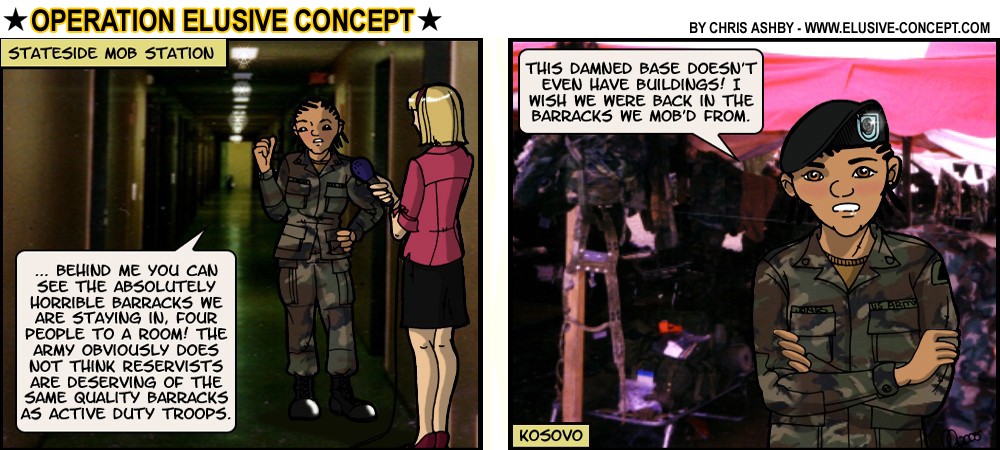
For more of Chris Ashby's amazing artwork and cartoons: www.elusive-concept.com
Our lack of having MOBILE ISO containerized housing for EVERYTHING we own and to live in results in us living in flimsy tents which do not protect from the earth environment let alone enemy weapons on the non-linear battlefield. We then alienate the civilians by occupying their static buildings as "invaders" starting rebellions against us. To try to counteract this, we then waste $BILLIONS on civilian contractors to erect flimsy buildings we will just leave behind when the locals finally compel us to stop squatting in their country so the cycle of unreadiness and desperation waste continues.
Proof U.S. Navy is already using ISO containers as living modules
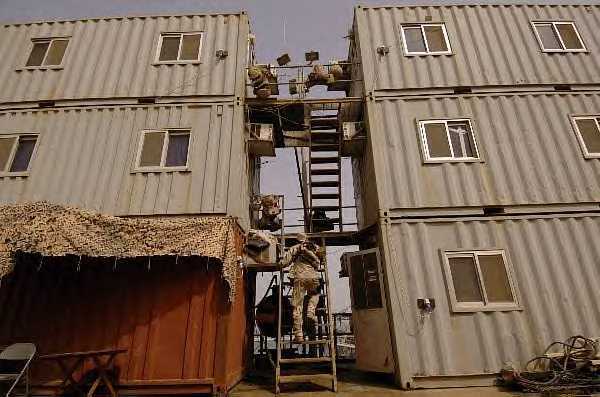
www.navy.mil/management/photodb/webphoto/web_050612-N-4309A-335.jpg
Master-at-Arms 2nd class Adam Ortega, assigned to Mobile Security Detachment Two Five (MSD-25), makes his way to his sleeping quarters after completing a long watch.
A new key concept that would get the U.S. Army ALWAYS ready to deploy & fight would be our new "Battle Box" concept using a family of Army ISO sea/air/land containers. We can no longer waste time playing "From Here to Eternity" garrison games centered on absurd sports PT for narcissists, garrison lawn mowing, floor and boot polishing, paperwork, meetings, change of command and retirement ceremonies when the lethality of the NLB requires us to spend EVERY waking moment on improving COMBAT capabilities. The same BattleBoxes we train in, we deploy with without repacking or the deployment gymnastics we do now with flimsy tents. BattleBoxes are able to be quickly fortified without piling sandbags and Hesco concertainers by piling soil around them and then using Envirotac II (aka "Rhino Snot") as a dirt sealant. Once we pile up dirt around our BattleBoxes and we want it and the general area not to turn to mud, we can spray Rhino Snot on it to turn it into an instantly waterproof hard pavement. Rhino Snot can be airdropped in specially modified M149 water buffalo trailer sprayer units ("Water Rhinos") to rapidly spray assault landing zones to make them into instant hard runways within 2-24 hours without time-consuming extremely heavy AM-2 matting (144 pounds for just one 2 foot by 4 foot section!). Details: www.combatreform.org/assaultzone.htm
Rhino Snot also prevents dangerous "brown out" helicopter crashes by making instant V/STOL landing zones.
The Army Science Board 1999 report; "Enabling Rapid and Decisive Strategic Maneuver for the Army After 2010" states:
"DOD shipping is too slow, takes too long to load and off-load, and requires too much water. Commercial shipping, useful to the Army, is too slow, takes too long to load and off-load, but does have more potential port access. Neither DOD nor commercial shipping has fast, austere port off-load capabilities. Lack of consistent packaging and modularization standards in military is at odds with increased commercial utilization...Sea lift has been and will continue to be the primary transportation means for large army forces, equipment, and supplies VISA is decreasing in utility due to dwindling U.S. shipping sector Army has an opportunity to improve the port to port time by 40% and load/unload time by 75%. Time window to influence High Speed Ships (HSS) opportunity is short and issues are complex. Recommendations [is] Forward to the Navy revised Army requirements for strategic sea lift to include HSS. Enter into partnership with the Navy and DOT to pursue Title XI support for HSS and support the immediate incorporation of National Defense Features (NDF) to support military cargo and austere port operations. Work with DARPA and Navy to develop technology alternatives to off-load ships rapidly in austere ports and across the shore. Advocate (Army Executive Agent) DoD-wide packaging standards consistent with best commercial industrial practices and have TRADOC develop and promulgate the associated TTPs to decrease loading time using containers, flat racks and other intermodal devices (Equally applicable to air)"
Furthermore, Army forces must not take months and months to deploy making themselves easy to target by enemy Weapons of Mass Destruction (WMDs) delivered by aircraft, missiles or even saboteurs. What forces we have must be dispersed and fortified in Battle Boxes.
The U.S. Army makes pie-in-the-sky claims of capabilities they want to have on their TRADOC web page below:
http://tradoc.monroe.army.mil/tpubs/pams/p525-66.htm
As long as these boasts can only be done by the multi-billion dollar Future Combat System (FCS) fantasy set of vehicles for just the heavy parts of the Army (5 division's worth) as the narcissistic, egomaniac, snobby status quo stays intact these goals will be pontificated on and $BILLIONS spent while our troops in danger ride to their deaths in Humvee/Stryker wheeled trucks with some armor slapped on top. The truth is these goals can be ATTAINED TODAY with EXISTING EQUIPMENT if the Army would just have an attitude change. The excerpt below illustrates what they claim to want to be able to do that our AWSOM achieves. We added hyperlinks on all of their claims to show you how they are do-able today if the Army was serious about being ready to fight. The current Boeing FCS at 26 tons cannot meet these requirements. Its likely the 20-ton Stryker truck deathtrap will become the defacto "FCS" in the incompetent minds of the idiots now in charge of America's Army when Congress pulls the plug on the costly science fair. Neither 20+-ton Stryker trucks or 26-ton FCS vehicles can fly in C-130s, CRAF cargo 747s, nor any existing U.S. helicopter for "vertical lift". Result will be an Army that can neither rapidly deploy or fight better than M16 versus AK47 since these bloated vehicles are TOO HEAVY TO MOVE THROUGH CLOSED TERRAIN, so infantry will have to fight on foot.
Chapter 2
Strategic Responsiveness and Deployability
|
Meet deployability standard of brigade on the ground in 96 hours after liftoff, a Division in 120 hours and 5 Divisions in 30 days. Overwhelm enemy's anti-access efforts. Enter at multiple, austere, dispersed points of entry, and employ coherent, combined arms units upon arrival, with a limited pause for Reception, Staging, Onward Movement, and Integration (RSOI). Force must be deployable within the framework of the C-130 crucible, and capable of vertical lift to operational distances. Objective Force must be capable of rapid transshipment between modes of transportation, without adaptors or need for reconfiguration. Must be capable of conducting logistics over the shore. Force is capable of conducting Enroute Mission Planning and Rehearsal. Joint In-Transit Visibility required throughout deployment. |
2-1. FOC-02-01: Deployability.
a. CAPSTONE CAPABILITIES:
(1) The Objective Force must, within a joint context, be capable of rapidly deploying worldwide, and arrive ready to fight, or conduct other full spectrum operations, immediately upon arrival. Forces must arrive capable of conducting continuous operations for up to 3 days at high operational intensity, and up to 7 days in medium to low operational environment, before it must be resupplied. Commonality of systems and components, reduced demand for fuel, ammunition, and power generation, and advanced sustainment technologies, will reduce the logistical footprint in theater. This will reduce the deployment burden, and maximize the mobility of the force in theater. Equipment will be designed and developed having both required warfighting capabilities, and the ability for strategic deployability on existing and emerging Air Force transport aircraft, Civil Reserve Air Fleet (CRAF), and intratheater airlift, via future fixed or rotary wing. By sizing systems and organizations against the C-130, we increase the options available to the combatant commander for entering forces into theater; we can combine available C-130 and C-17s to maximize force flow using multiple entry points to bring in combat configured units. The Objective Force can combine available C-130's and C-17s to maximize force flow using multiple entry points to bring in combat configured units. The operational concept is to 'Fight on Arrival' without traditional support requirements. This does not mean the platforms must 'Fight off the Ramp', but are prepared to quickly fight once off the ramp. [EDITOR THIS IS A CRUTCH TO EXCUSE AWAY THE BULLSHIT STRYKER TRUCK THAT CANNOT DEPLOY COMBAT LOADED FROM A C-130 BECAUSE ITS TOO HEAVY] Without a substantial assembly or refit process by the crew, the FCS systems must be placed in an Essential Combat Configuration (ECC) to be combat mission ready. A full basic load and full fuel tank is not required, but each vehicle must arrive with a full turret or fighting load of ammunition and 3/4 tank of fuel, with its full crew and passengers with their personal equipment. It must be capable of immediate self-defense, arrive connected to the command, control, communications, computers, intelligence, surveillance and reconnaissance (C4ISR) network, enabling full situational awareness/situational understanding (SA/SU), and able to access networked fires, including joint fires. The UA will be capable of upgrading to Full Combat Configuration within 15 minutes of arrival with all add on armor kits applied. Full Combat Configuration enables the UA to conduct the full spectrum of operations, and adds capabilities like enhanced mine survivability, or add-on armor. Full Combat Configuration includes all of the ECC capabilities, plus full fuel and basic loads, needed for 72 hours of high tempo operations.
The future combat system (FCS) family of systems (FoS) must meet the Army force deployment guidelines (Threshold), and be capable of transport on commercial contracted airframes and vessels, in accordance with (IAW) the CRAF guidelines, and the Voluntary Intermodal Shipping Agreement (Objective). The FCS FoS shall be transportable worldwide, without disassembly, at their gross vehicle weights/combat weights by highway, rail, water, and air modes. The FCS FoS must be transportable, without U.S. Air Force airlift waiver, with essential combat load, and with no shoring of any type. It must be transportable on C-130 profile aircraft, maritime prepositioned ships, rail, and ground transport (Threshold), and all current strategic/tactical transport aircraft, shallow draft high-speed sealift, and landing craft (Objective).
(2) Objective Forces must be capable of entry operations, including forcible entry operations. The Future Operational Environment for deployment includes projection into underdeveloped nations, with limited ports, or nations with developed infrastructures, where threat antiaccess actions have degraded or denied seaports. The entry of Objective Forces into the theater, at multiple decisive points, mitigates antiaccess, and places enemy capabilities at risk. This acceleration of the force flow of combat power provides the Joint Task Force (JTF) Commander the flexibility to decide how, where, and when to initiate combat, seize the initiative, and build momentum rapidly, to achieve decisive outcomes.
(3) To accomplish strategically responsive, rapid deployability, the Objective Forces will require strategic and operational lift capabilities, to facilitate strategic responsiveness, operational maneuver, and tactical maneuver. The most significant new capabilities required include shallow-draft, high-speed ships, super short take-off and landing (SSTOL) aircraft, and advanced, heavy-lift rotary-wing aircraft. Objective Force units must be transportable by inter/intratheater land, sea vessel, and airlift, anywhere in the world. They are more deployable with reduced deployment tonnage, and must be transportable by C-130 profile aircraft, and advanced vertical lift, such as air maneuver transport, advanced theater transport, ultra-fast shallow draft sealift, or Theater Support Vessel. Additionally, the Objective Force requires advanced over-the-shore capabilities, broader ability to use unimproved ports and airfields, and very rapid positioning of theater-opening enablers. These capabilities permit the joint force/Corps commander to push substantial, ready-to-fight land power ashore through multiple, unimproved entry points. These capabilities are required to enable the deployment of a brigade combat team, anywhere in the world, in 96 hours after liftoff; a warfighting division on the ground in 120 hours; and five divisions in theater in 30 days.
UPDATE 2007: Maritime Modular Maneuver 21
Sea logistics DELIVERY not just sea BASING
EXCLUSIVE! click here to see and hear 1st TSG (A)'s SeaBasing 21 mini-movie "We Can Be Heroes"
Has actual video of LCACs interfacing with sealift ships using air cushion vehicle landing platforms...
EFFECTS-based not means centered; goal is to deliver and sustain decisive air-ground maneuver not linger at sea as a target. Start with what we want to achieve on LAND where humans live and where governments that we want to influence are and then work backwards from the delivery and preparations. The Sea is a means to an end, not an end unto itself. If it weren't, we would build huge off-shore bases with runways and suffer the enemy targeting consequences akin to the 007 movie "The Spy Who Loved Me" when shipping tycoon Stromberg's floating base was destroyed by a nuclear submarine.
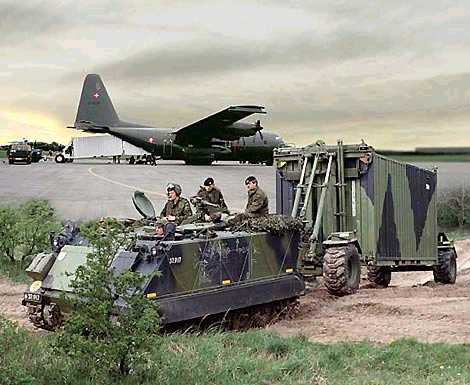
INSPIRATION FROM WORLD WAR 2 D-DAY
www.youtube.com/watch?v=-O-bMTKtJlg
PART 2: massed naval gunfire, rocket ships, Gallipoli fubar wrongly interpreted as due to a lack of amphibious means when it was the terrain, Higgins boats, neglect to remind audience that Japs came up with idea first, Bren gun carrier offload from landing craft, steel LCAs better than cheap plywood LCVPs,
 www.youtube.com/watch?v=HY1HzqwnJ0c
www.youtube.com/watch?v=HY1HzqwnJ0c
PART 3: heavy bombers redirected to smash Luftwaffe, P-51s re-engined to escort them and do fighter sweeps on the ground of rail to isolate beachhead, medium bombers cleverly dropped bombs to make craters for infantry to have cover from German fire, DUKWs created by Rod Stevens, Churchill creates the LST
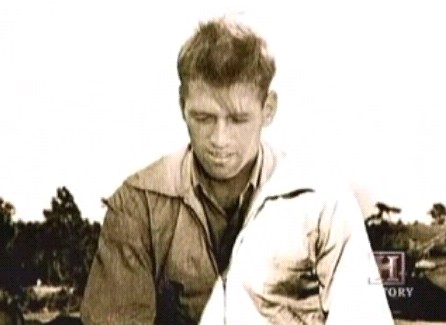
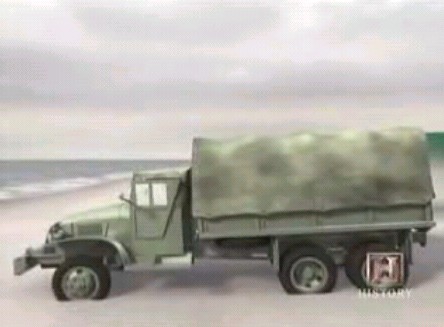
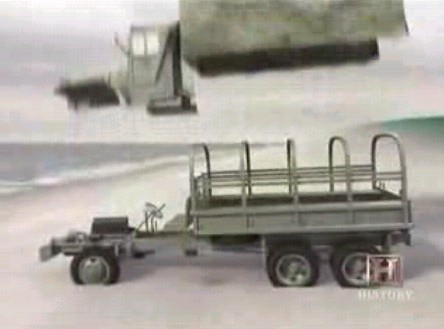
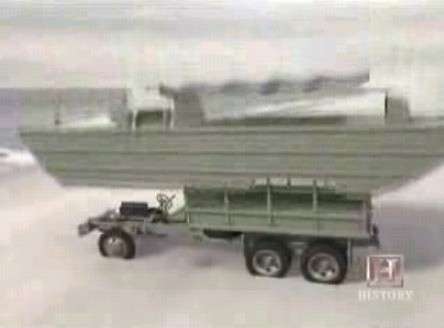
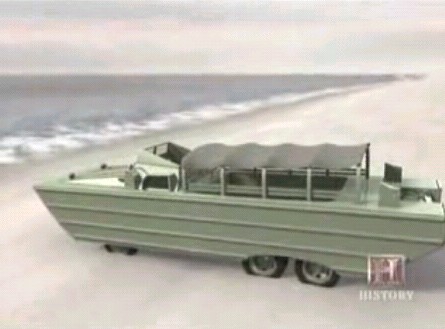
 www.youtube.com/watch?v=rwox9PIDkEo
www.youtube.com/watch?v=rwox9PIDkEo
PART 4: LSTs, DUKWs, Dieppe fubar, don't attack a port directly, Mulberry port devices, huge 200 foot caisson breakwater blocks, ships sunk as breakwaters, complete LST off-load in 40 minutes by Mulberry pier instead of 6 hours on the beaches from LST, storms smash Mulberries
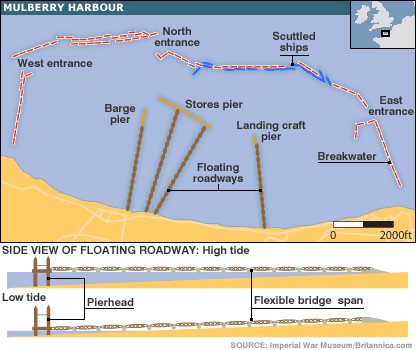
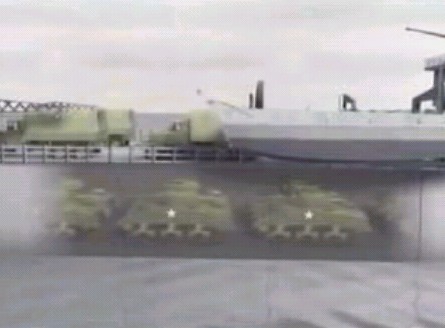
 www.youtube.com/watch?v=uU1jJ0Nq1JQ
www.youtube.com/watch?v=uU1jJ0Nq1JQ
PART 5: DUKWs save the day when Mulberry harbors destroyed by rough weather, shows need for overlapping capabilities,
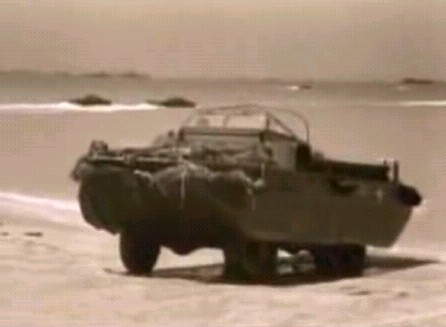
 www.youtube.com/v/CtLZ3G0hRds
www.youtube.com/v/CtLZ3G0hRds
1. CONTAINERIZE
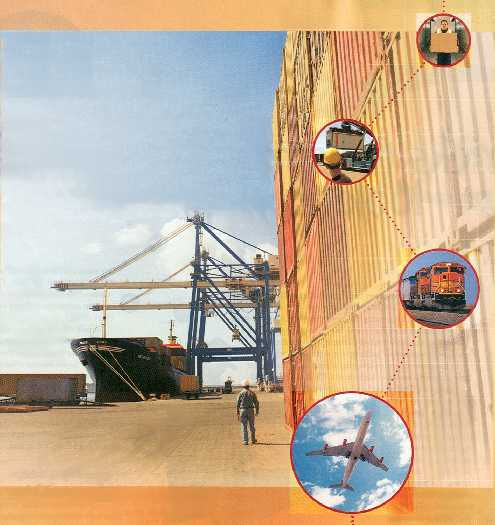
FM 55-80, Army Container Operations, Chapter 1 Introduction to Intermodalism states:
http://155.217.58.58/cgi-bin/atdl.dll/fm/55-80/ch1.htm
The transition to a CONUS-based, power projection force increases the need for the Army to be able to rapidly deploy anywhere, anytime. Strategic lift must be maximized to rapidly project power to meet our force projection goals. Strategic lift is supplied by either ocean-going vessels or air transport. Both are limited resources. Having the largest requirement for strategic lift demands that the Army maximize its use of containerization. Containerization increases the types of ships available to support strategic deployment as well as increasing the cargo capacity of other available ships. It also streamlines handling requirements within the distribution system. Other added bonuses of containerization are increased protection against shipping damage and safeguards against pilferage."
"The DOD relies on commercial sealift to move 85 percent of cargo during contingency operations. The U.S. and world merchant fleets are dominated by large, fast containerships with supporting corporate infrastructure (for example, CHE [Container Handling Equipment], terminals, information systems, tractors/chassis, and experienced personnel). Experience in ODS [Operation Desert Storm] revealed that DOD was unprepared to use effectively, containers and containerships to move UE [Unit Equipment] and ammunition. This contributed, in conjunction with port saturation and lack of ITV, to the slow deployment of CS/CSS forces and resulted in significant delays in moving Class V [ammunition] resupply. Also, large numbers of small, slow breakbulk vessels were used instead of containerships which resulted in significant costs in time and money.
End State: entire Army is mobile and dispersed through hardened ISO container "Battle Boxes" (BBs). Containerized Army is always ready to fight training now in peacetime exactly as it would in war; when deploys overseas does NOT have to occupy buildings and inflame locals and make selves targets. Hardened forward operating bases with walled perimeters created by ISO Battle Boxes in rural areas out of sight of indigenous populace to maintain OPSEC and not be seen as invaders. Battle Box FOBs can pick up and move constantly to avoid enemy targeting. BB hard shell offers complete climate, small arms fire, mortars, artillery and WMD protection capabilities compared to current rotting canvass "tent cities". Ability for energy self-sufficiency through solar panels. Details:
www.reocities.com/strategicmaneuver/battleboxes.htm
Containerized Army can rapidly deploy by air, land (rail, trucks, tracks), sea with several month's worth of supplies.
Air--light units have their assault echelons reinforced by the airland arrival of aluminum ISO Battle Boxes with flush bottoms to fly 8 at a time per C-17. Both light and heavy unit's ISO BBs can be sling-loaded by Army heavy lift helicopters.
Land--all ISO Battle boxes can be towed by Army wheeled and tracked vehicles, placed on PLS vehicles, railroad cars.
Sea--all ISO BBs can rapidly load/offload on/off leased container ships which can carry from 2,000 to 8,000 containers. Container ships have their own container cranes to load/offload containers at rate of 1 per minute. The only container ships that should be owned are FastShips that can beach themselves ashore after a 40 knot transit. The key to survivability in the 21st century battlefield is to get there, do your mission and get out.
Cost per ISO BB is $5,000. A Brigade needing 500 BBs would require $2.5M. The Army has planned to expand to 40 BDEs so total cost is $100M to containerize entire U.S. Army.
2. EXPLOIT CONTAINERIZATION USING EXISTING AND FAST SEALIFT
Four David Giles FASTShips that hold 5,000 ISO BBs at 40 knot speeds purchased for the west and east coast. Defensive anti-missile armament and flight decks included. When Army units receive orders to deploy their ISO BBs are taken to port within hours and loaded up with their food, water and ammunition ISO BBs. FASTShip(s) set sail at 40+ mph to area of operations anywhere in the world within 10 days. Soldiers can be embarked on FASTShip(s) living out of their ISO BBs or fly and link-up later with their equipment. FASTShips if sea lanes are clear of mines either pull alongside a port pier and offload under 24 hours or beach its bow and offload like a Landing Ship Tank (LST) to effect the same timely offload.
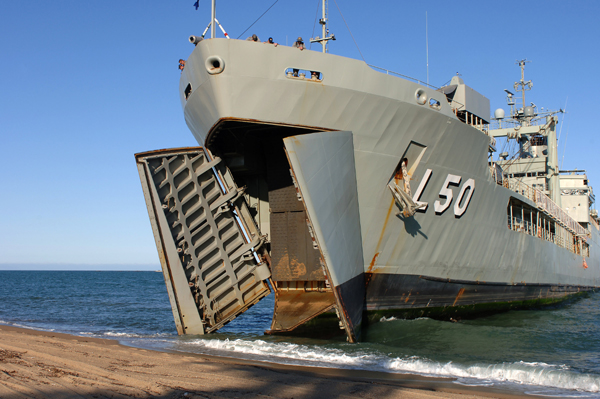

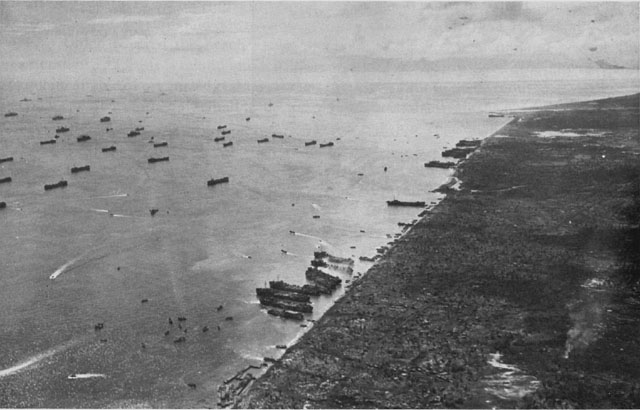

The FASTShips would rapidly shuttle back and forth to get follow-on echelons to the fight.
Cost per FASTShip is $300M. Four would be $1.2B.
FASTSHIP-David Giles
From their web site:
www.fastshipatlantic.com
FastShip, Inc.
1700 Market Street, Suite 2720
Philadelphia, PA 19103
(215) 574-1770
fastship@fastshipatlantic.com
FastShip, Inc., with its strategic partners, is building an international time-definite express freight service to exploit the void between high cost airfreight and low cost, but slow speed ocean services (the "middle market"). The FastShip transportation and logistics network is designed to serve the increasing demands of the fastest growing segment of the freight market: international, time-definite delivery/logistics services. Initial commercial service will be on the North Atlantic, connecting destinations to the middle of the U.S. and Europe via the ports of Philadelphia and Cherbourg, France. Once the North Atlantic service is established, FastShip will develop into global network with subsequent services for trans-Pacific, intra-Asia and other routes.With its initial networks linking North America and Europe, FastShip will provide door-to-door service times comparable to standard airfreight at half the cost.
CURRENT STATUS
We are in the process of developing the financing to build the first three ships, the terminals in Philadelphia and Cherbourg, and to launch the North Atlantic service.
The ships are designed, tested and classified. Spanish shipbuilder IZAR will begin detailed design and construction as soon as the financing is in place. The loading system is designed, with an operational prototype in Bergen, Norway. Terminals have been designed and simulated. Key strategic partnerships are in place with world-class companies committed to making FastShip a success.
Commercial service is expected to begin in 2008.
BUSINESS DESCRIPTION
FastShip's seven-day service will reach from Chicago to Frankfurt. Locations closer to Philadelphia and Cherbourg would get faster service-New York to Paris would be six days, for example. FastShip service will also be highly competitive in catchment areas beyond the seven-day boundary.
Because the FastShip service will be substantially faster than conventional ocean transportation, but will charge rates substantially lower than airfreight rates, FastShip will provide a unique service that meets a strategically essential need for a growing number of commercial shippers who are focused on aggressively reducing inventory in their supply chains, while improving customer service.
The FastShip transportation service is based on several critical technologies, utilizing three high-speed vessels with capacity of 10,000 tonnes each, seamlessly integrated with a horizontal, rail-based, on/off-load system. The patented FastShip vessel will be capable of carrying container loads across the North Atlantic at 38 knots (44 mph) (100 hours port-to-port including 10 hour buffer), even in high sea states, ensuring a high degree of service reliability (98% on-hour port arrival).
Furthermore, FastShip has an exclusive license to use a patented cargo handling system, the Container Platform-Train system ("CP-T") developed by TTS Technology ASA, which will speed the loading and unloading of the ship, enabling a complete turnaround of the vessel within six hours of port arrival, versus up to 24 hours for traditional ocean carriers. The time saved in terminal operations is the equivalent of adding a further 10 knots (12 mph) of speed to the ships. Moreover, the ship and loading system designs provide great flexibility in the types of cargoes that can be carried and can accommodate containers, project cargo, specialized racking systems, and roll-on/roll-off ("Ro-Ro") cargo.
FastShip will use dedicated terminal facilities strategically positioned in Philadelphia, Pennsylvania and Cherbourg, France. Both terminal locations are far-removed from the congestion that plagues many major ports such as New York, Rotterdam or le Havre, thereby eliminating bottlenecks and expediting inland movement of cargo.
The Company plans to develop relationships with leading transportation management and logistics companies to manage the inland transportation system to high service standards that are employed in the trucking industry today, further facilitating rapid and reliable door-to-door movement of goods.
As a result, the FastShip network will perform in a manner that is very different from the conventional airfreight and ocean freight industry approach and, instead, more closely resembles the operating philosophy used by the integrators such as FedEx and UPS.
Assured on-time arrival of the ship makes it possible to synchronize the terminal and inland operations with the ship arrival, eliminating the substantial frictional time loss that normally occurs at the port interface with conventional operators.
Movement of the container is planned end-to-end from the time the initial order is taken Flow-through process end-to-end; "one touch" terminal handling approach keeps the freight continually in motion and avoids the "rack, stack and hold" approach of the conventional operators
Committed inland transportation capacity key for high quality synchronized hand-off at the port interface and for reliable delivery; substantial change from spot purchase approach of conventional operators. Completely integrated IT and communications within network and to customer; total visibility of cargo in transit
Quality express service
With a high frequency of sailings, rapid and reliable service, dedicated terminals, and a system tailored to the needs of HVTS cargo, FastShip will be able to meet its business objective of revolutionizing international freight transportation.
FastShip's unique technology has direct military applications, which is of particular value in an era when fast deployment of forces and humanitarian aide is of such critical importance.
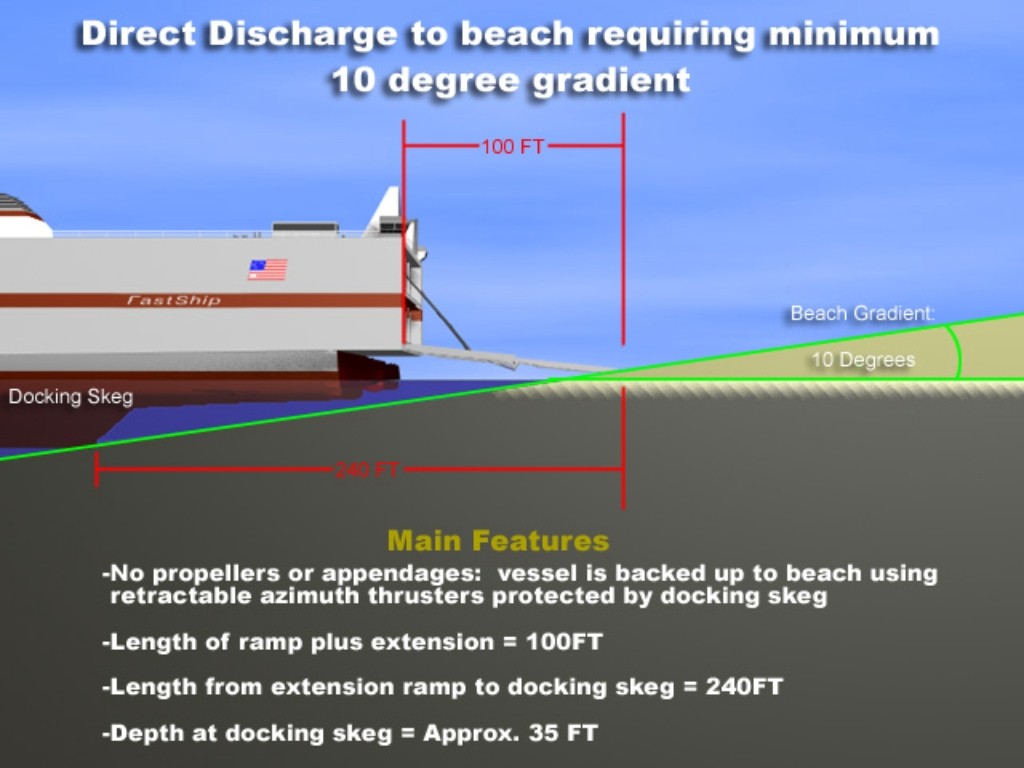
With the addition of very simple, low-cost military features that can be installed in 48 hours, the commercial FastShip can quickly be converted to a roll-on roll-off ship that can carry wheeled and tracked vehicles, containers and personnel. The ship can operate in undeveloped ports and even unload directly to a beach. This capability provides unparalleled speed and flexibility in handling strategic deployments of military equipment.
As an example, by using one FastShip vessel, the U.S. military would be able to move two entire armored battalions (including personnel, vehicles and 30 days worth of combat supplies) from North America to an unimproved Persian Gulf port in less than 11 days. That is less than one-half of the time it would take conventional sealift. And, given the nature of the cargo, it would be virtually impossible and extremely expensive to accomplish this same feat with airlift.
The FastShip design, which is adaptable and scalable, could have direct application to other defense requirements both combat and logistical, including sea-basing.
3. EMPLOY COMMERCIAL OFF-THE-SHELF ISO BB LIFTING SKYCRANE HELICOPTERS
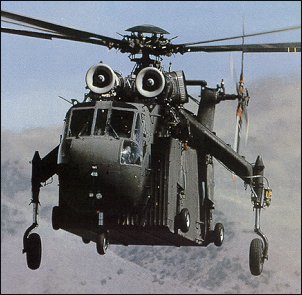
If for some reason the FastShips and container ships cannot offload pierside or on the beach, a LOTS operation will be required. Erickson AirCrane makes the S-64 SkyCrane which can be purchased at $20M each with CH-53E engines and rotors to lift 20 tons for 200 miles. Called "AirCranes" these would lift the ISO BBs from ship-to-shore in addition to existing Army LOTS watercraft.
Inland, AirCranes would be able to resupply modular FOBs with BBs full of vital supplies flying over roads that are easily ambushed by the enemy. AirCranes can also move entire FOBs by air as required to not present a known target to the enemy.
AirCranes can "Air-Mech" M113A4 MTVL Gavin Infantry Carriers and M8 Buford AGS/Tracer light tanks for 3D maneuvers in conjunction with 2D maneuvers done by forces in medium M2 Bradley Infantry Carriers and M1 Abrams heavy tanks.
AirCranes with "people pods" could transport Soldiers at high 200 mph speeds if fitted with wings and thrust turbofan engines or vectored thrust ducted propeller units. Just-In-Time precision resupply in small bundles using disposable CopterBox for small units and ECDS pallets to large units could be effected. Details:
www.combatreform.org/abnlogistics.htm
Cost per AirCrane is $20M. For a fleet of 50 AirCranes, 25 on west and east coasts would be $1B.
4. COMPLIMENT EXISTING PREPO AND SURGE RO-RO SEALIFT SHIPS
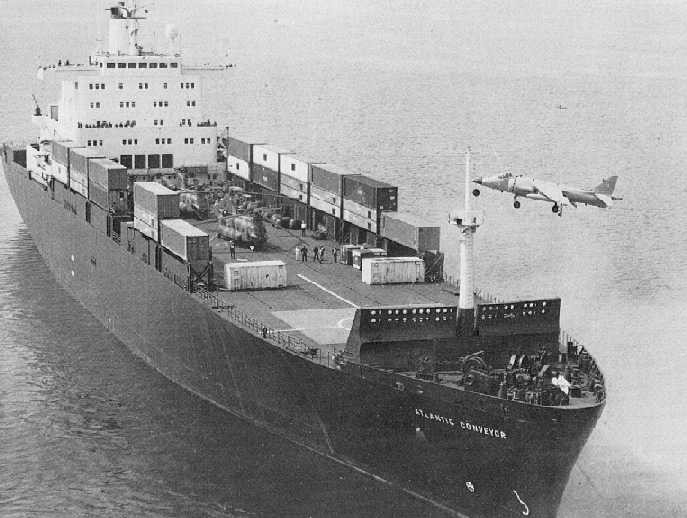
The British were highly sucessful converting container ships into aircraft carriers; the extra Harrier STOVL jets the Atlantic Conveyor brought prevented the Argentine Navy from sinking their fleet and thus, won the war for them.
British have already done it: Container Ship Conversion to Aircraft Carrier: Arapaho, SCADS and SkyHook
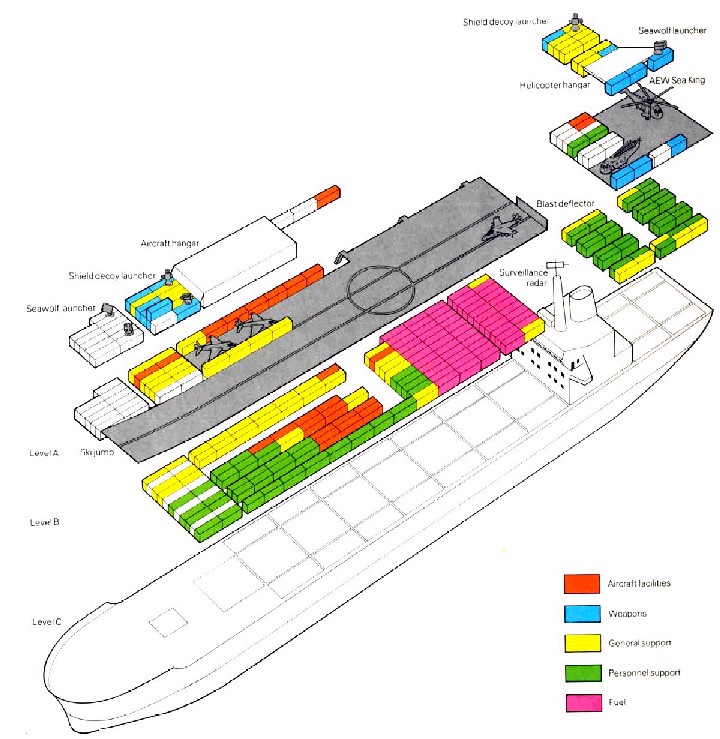
SCADS: Shipboard Containerized Air Defense System
http://home.planet.nl/~alder010/Future/Future.html
Future and Specials
In the late 1960s the U.S. Navy had conceived the "Arapaho" programme, under which a container ship would be modified to permit testing of its suitability to operate special mission helicopters. The aim at that time was to allow a significant proportion of wartime convoy escort and sealane protection tasks to be performed by such ships, manned by USN reservists. The Arapaho concept involved an LPD-size flight deck 200 feet (61m) long and 64 feet (19.5m) wide, and a 4,000 sq ft (372mē) hangar large enough to accommodate four Sea King [amphibious] helicopters. The complete installation weighed 900 tons, and could be installed on a container vessel in less than 18 hours.
In 1982 such an installation was emplaced on the 18,000-ton Export Leander, and 178 helicopters landings and take-offs were performed. In the following year the Arapaho equipment was leased by McDonnell and installed by Camel Laird at Birkenhead on the 27,900-ton MV Astronomer (subsequently renamed RFA Reliant) for tests in the South Atlantic.
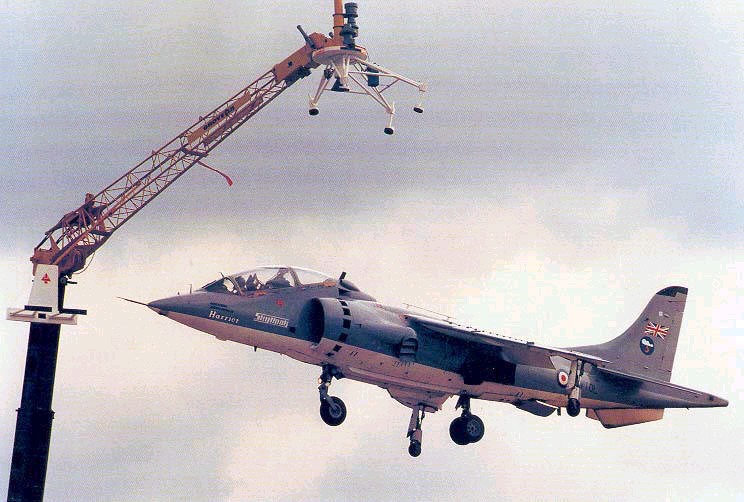
In efforts to exploit the sales potential of the Sea Harrier, which rested largely on its ability to operate from small, inexpensive ships, British Aerospace proposed the installation of ski-jump decks on commercial vessels, and the 'Skyhook' concept that would allow such aircraft to operate in the VTOL mode from ships without any form of aircraft deck.
'Skyhook' was invented by Heinz Erwin Frick (a BAe test pilot of Swiss descent) and the corresponding specification No.2104014 was filed with the British Patent office in 1982. Frick had been struck by the ease with which a Sea Harrier can be hovered with great precision, regardless of wind variations. It occurred to him that if this hovering accuracy could be combined with a space-stabilised 'Skyhook' on a ship, then it could provide the means for the aircraft to recover to a highly mobile deck. If the design of the ship precluded the use of a ski-jump take-off, then the aircraft could depart from the 'Skyhook', although its warload radius performance would then be much more limited.
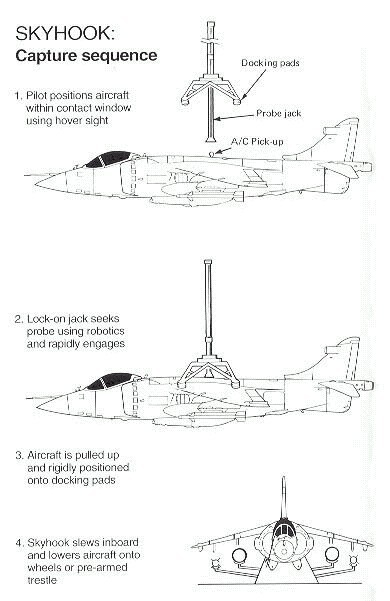
The concept required very little modification to the aircraft itself - simply a hoisting point above the centre of the gravity and possibly some local strengthening. If the operator wanted to refuel the aircraft while suspended from the "Skyhook", this would require modification of the fuel system, but it would still represent a minor expense. The major development task would be the advanced technology crane, presumably with an inertial platform in its base sending commands to a fast-acting hydraulic system that would keep the head of the crane moving linearly through space.
The computations for the crane system were based on the RN's 4,250-ton Sheffield class of destroyers, and the design allowed for sea state 6, to give uninterrupted operations in the North Atlantic for 97% of the time. Using a special form of display attached to the crane head to assist the pilot to hover accurately, it was concluded that the aircraft could easily be placed within the 'capture envelope' of the "Skyhook". Engagement was to be performed by a robot system, scanning IR-absorbent patches bonded to the upper surface of the aircraft around the pick-up probe, and moving the hook accordingly. An IR engagement-control system was proposed in order that the aircraft could be illuminated in night recoveries without affecting the pilot's night vision.
Despite the very limited warload-radius performance available from the "Skyhook" launch (which would be less restricted in the case of an AV-8B), the concept undoubtedly has some potential in the context of convoy protection and in providing an outer defensive perimeter by making use of radar picket ships around a conventional carrier. However, BAe estimated in the mid-1980s that the system would cost around $12 million to develop. The company also insisted on acting as prime contractor for "Skyhook", rather than granting a licence (eg, to a company in Japan, where the concept might have special attractions). In the event, UK-MoD showed no great interest and BAe was unwilling to invest its own funds in the project, so "Skyhook" has been filed away, at least for the present.
www.secretprojects.co.uk/forum/index.php?topic=1304.msg11194
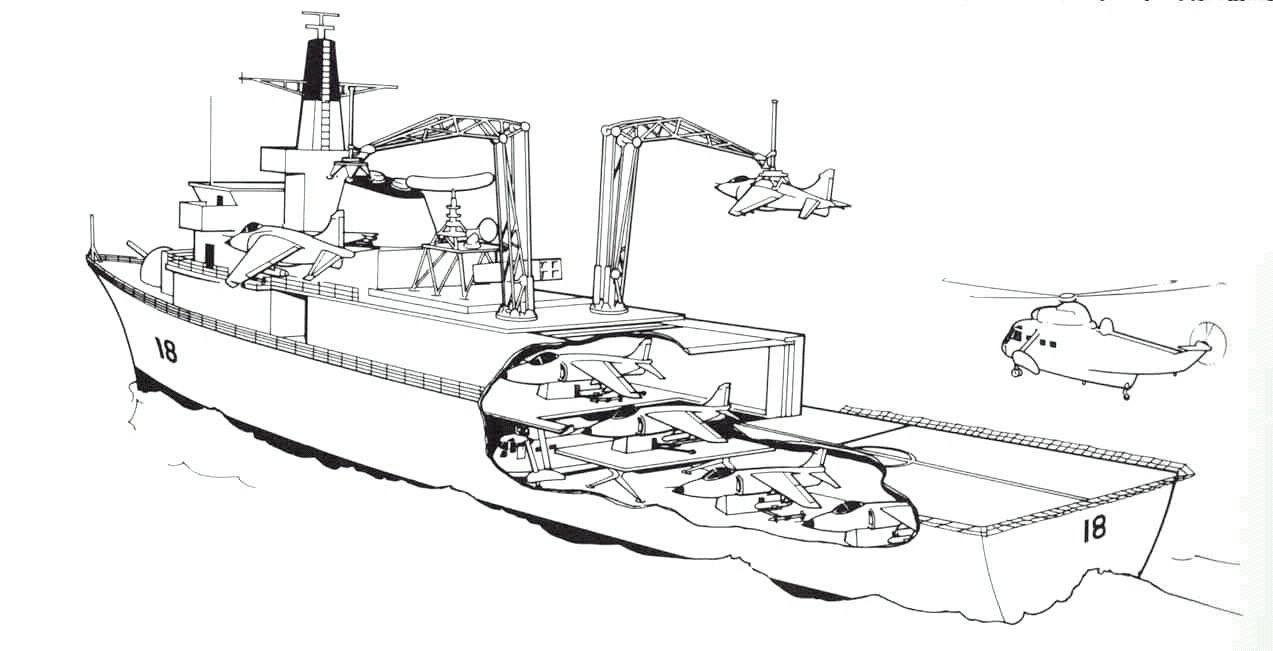
After the idea of SCADS BAe also came up with the SkyHook idea. The initial idea saw BAe propose two ships, one in their patent application (www.google.com/patents?vid=USPAT4523729&id=IcEyAAAAEBAJ&pg=PP2&dq=heinz+frick) and one used in publicity brochures.
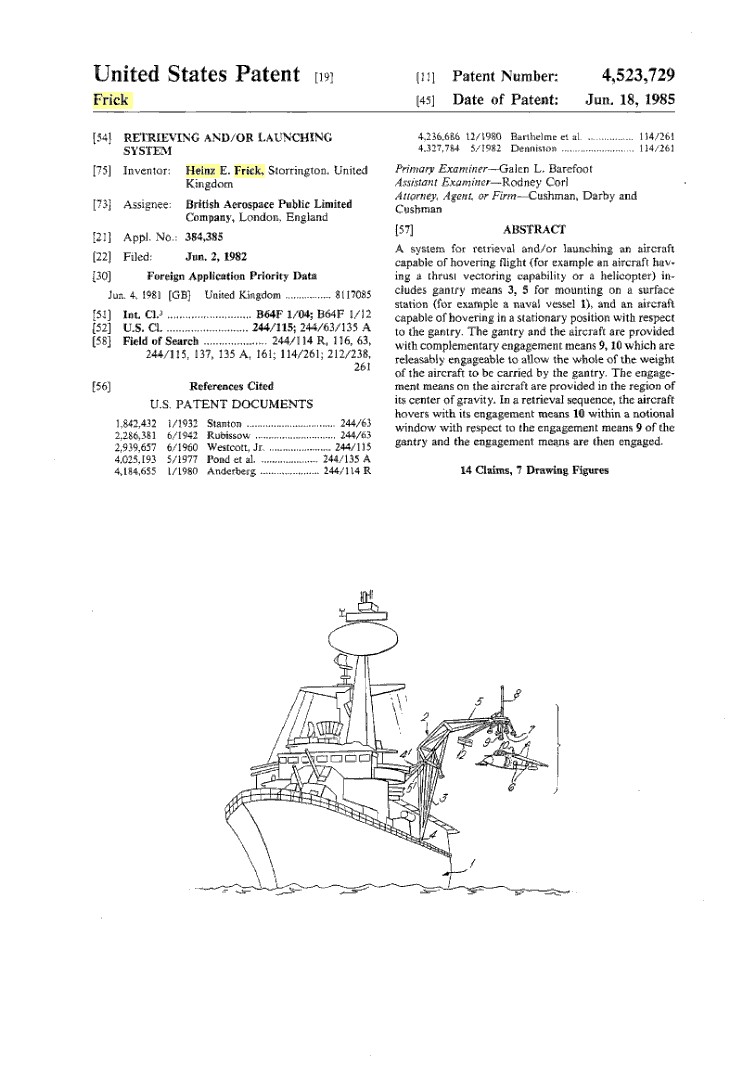
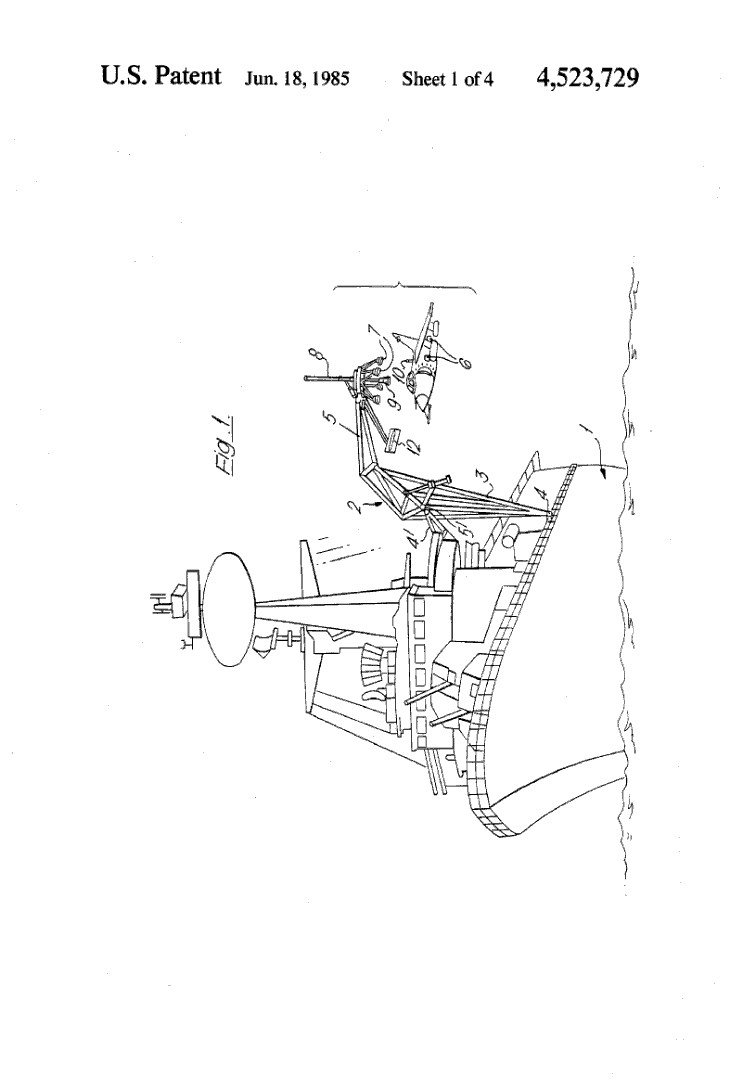
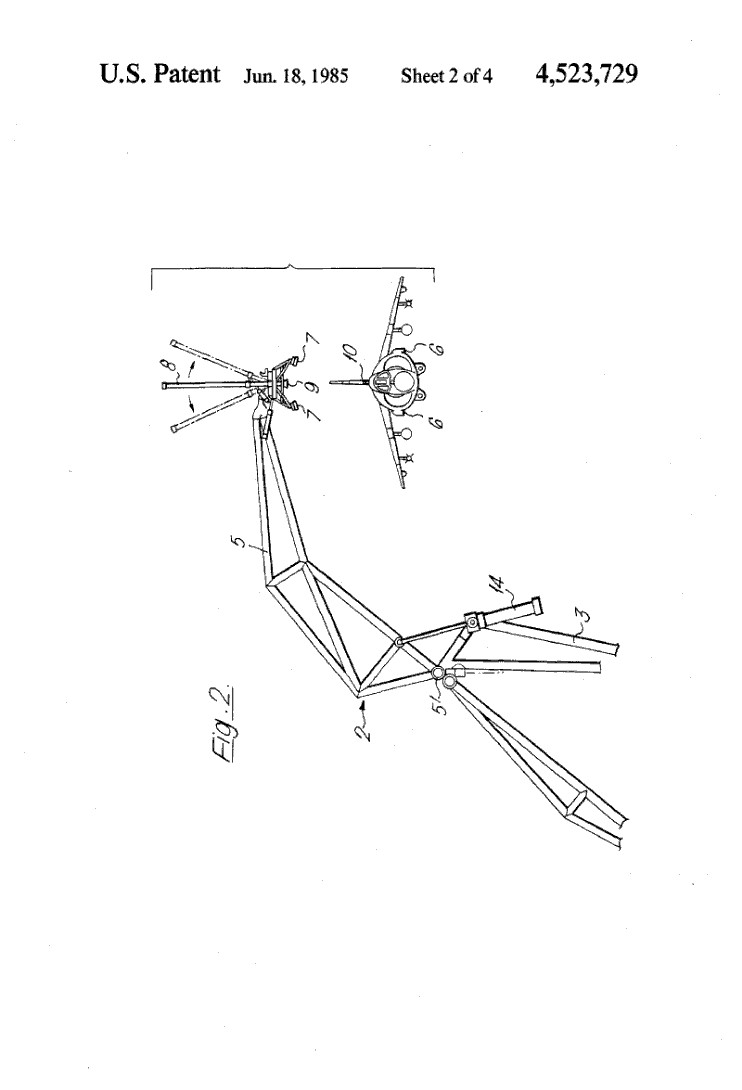
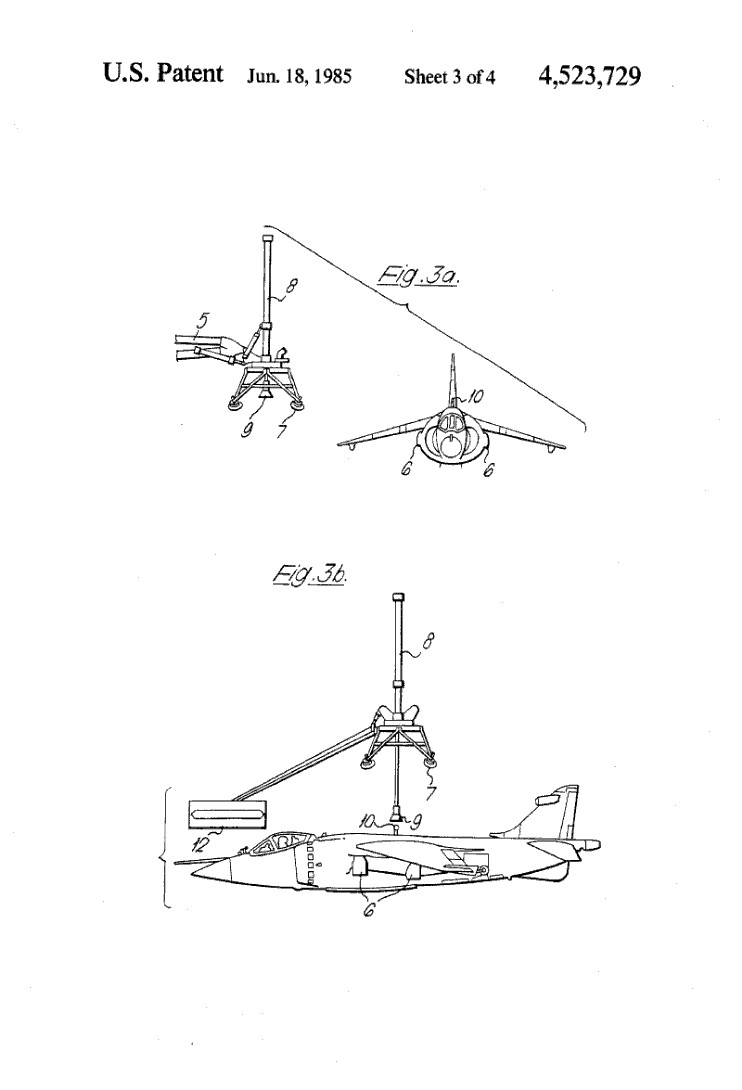
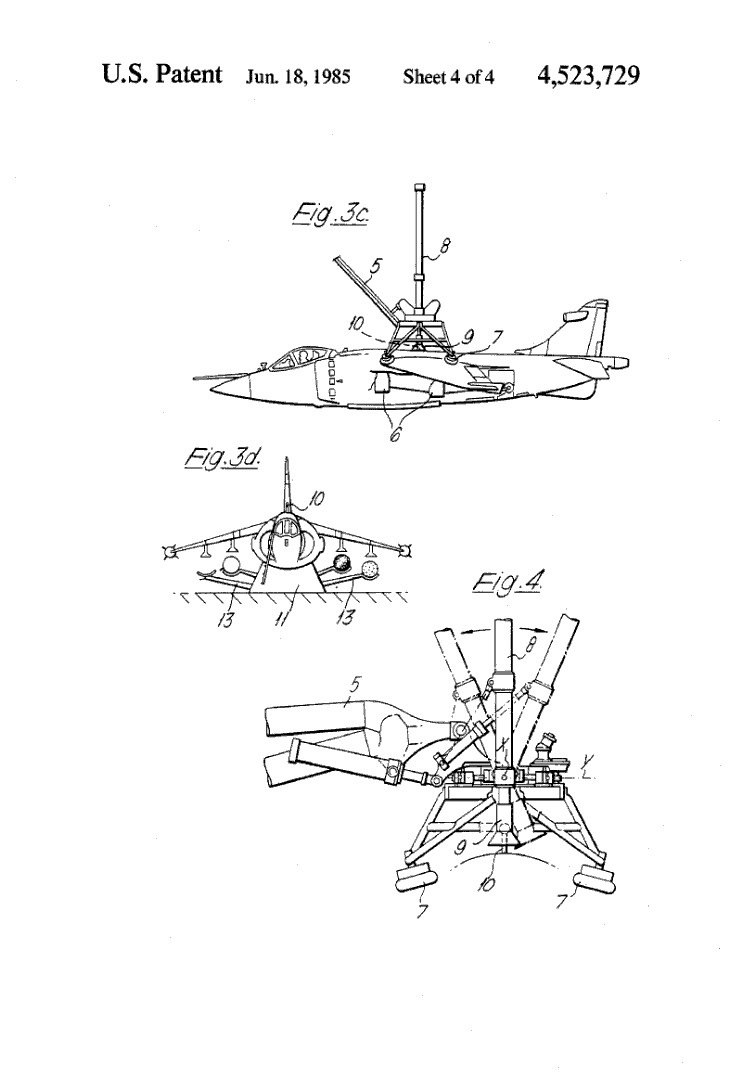
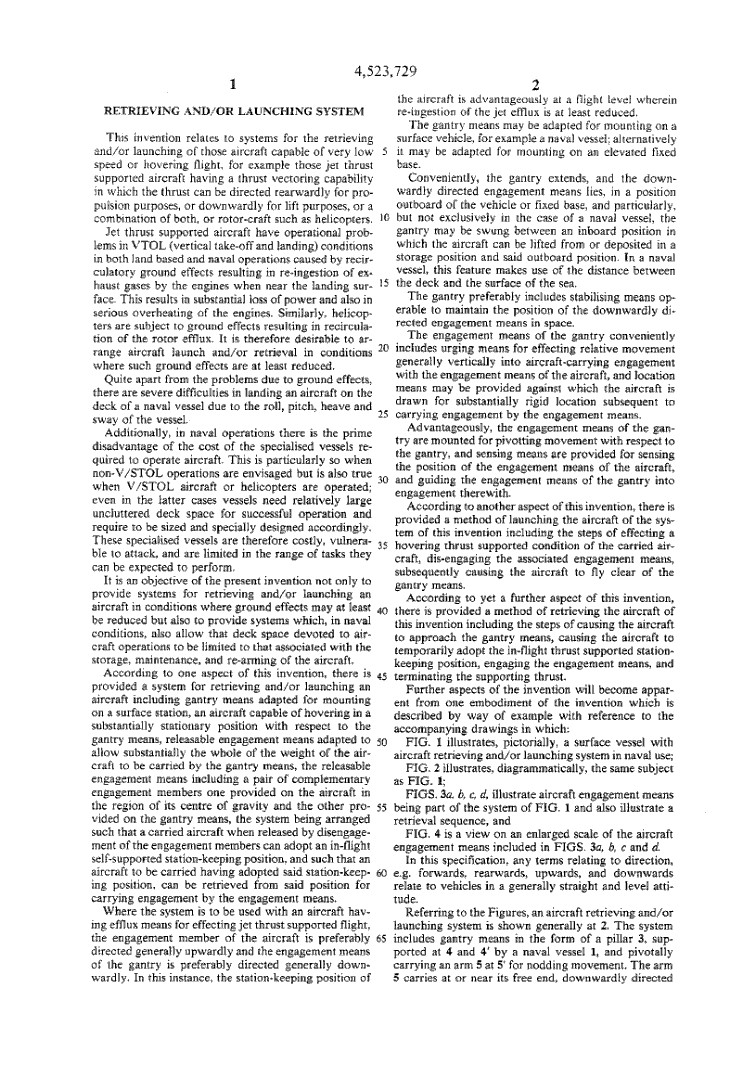

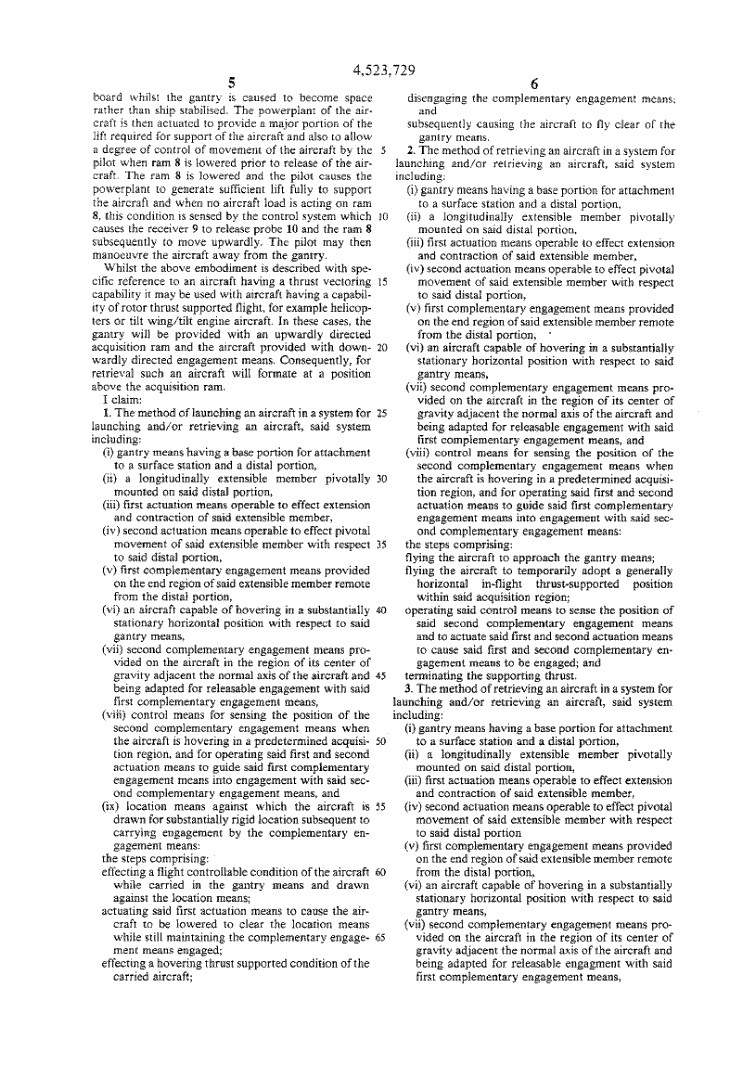


Both relied on SkyHook for take-off and landing, probably not too practical.
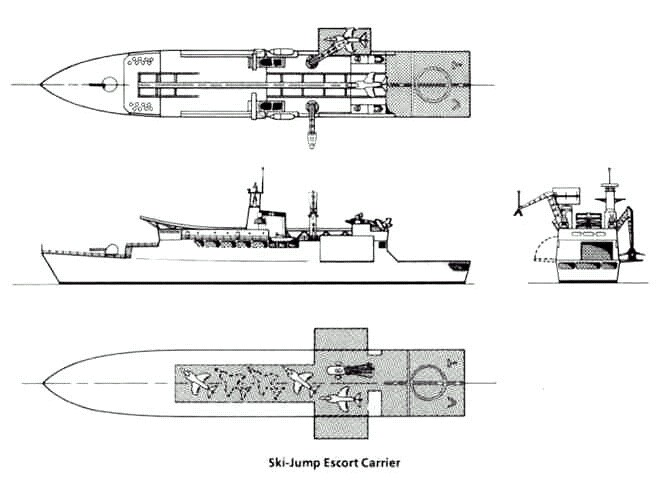
However, VT designed a "proper" ship around the concept and this featured a skeletal ski-jump atop the supersturcture for take-off. This increased payload, with recovery via SkyHook. Aircraft were stowed in a hangar with lateral doors for entry/exit, SkyHook being used to move aircraft to the launch position.
2x 25mm Sea Dragon CIWS, 1 medium gun, plus 16 x VLS missiles for defence.
5,200 tons diplacement, 416 feet 8in OA
45,000 shp = 26kts
5 x Sea Harriers, one helo.
The idea was to use the ship as a "forward base", allowing greater endurance in CAP patrols, with the aircraft returning to a large carrier for major maintenance. In other words, a naval version of the Harrier's land-based use of forward operating strips.
The British have already taken container ships to war in the Falklands in 1982. Snobby navies like the U.S. Navy want handfuls of custom-made "warships" and don't realize in war SIZE counts.
VIDEO: CHICOM Air-Mech 3:00, BATTLEBOXes 5:00
 www.youtube.com/watch?v=IafBYvu5UBo
www.youtube.com/watch?v=IafBYvu5UBo
The author below doesn't seem to know that its possible to offload container ships without having to seize container cranes at a port. He doesn't know about FASTship or SCADS, either but he's right on target with how container ships can be made into aircraft, troop and tank carrying ships.
www.americanthinker.com/2005/04/chinas_container_ship_fleet_an.html
April 11, 2005China's container ship fleet and Taiwan's security
By Frederick W. Stakelbeck, Jr.
China is busily building a fleet of the largest container ships the world has ever seen. That is a boon for its export trade and economic efficiency. But like the Trojan Horse of ancient Greek civilization, the fleet could potentially be used by China in a spectacular, lightening invasion of Taiwan. Could the hollow hulls and empty decks of Chinese container ships carry infantry and mechanized divisions for a devastating attack on Taiwan, securing the island before the U.S. could respond?
The thought of mammoth Chinese container ships carrying an amphibious invasion force across the Strait of Taiwan is certainly frightening. But the capability for just such an invasion is slowly being put in place.
The Chinese have plans to build several 90,000 ton-plus container ships capable of carrying 8,530-TEUs [EDITOR: 20 foot long shipping containers] (Twenty Feet Equivalent Units).* In an agreement announced in November 2004, Chinese shipbuilder Hudong-Zhonghua Shipbuilding (Group) Co., Ltd. announced it will deliver 4-5 of the giant container ships to the China Shipping Group by October 2008. When completed, the new ships will surpass the Republic of Korea's 8,000-TEU as the largest container ships in the world.
Supplementing increased construction and advances in the container ship industry have been developments in China's amphibious capabilities. The People's Liberation Army Navy (PLAN) is building amphibious ships at a breakneck pace. The ships include nine large Yuting 072- II class LSTH; the Yunshu class LSM; a new 64 meter LCU; a number of medium landing ships; and the construction of LSDs and LPDs with flight decks for attack helicopters.
Solidifying China's stranglehold on the world's merchant fleet is the country's rapid ascension as a world leader in commercial ship repair and conversion services. These complex projects can now be completed at a number of shipyards throughout China. Its largest ship repair organization, the China Ocean Shipping Company (COSCO) Shipyard, operates the Nantong shipyard near Shanghai, which is increasingly handling tanker, container and bulk carrier repairs and conversions. Separately, the Dailan and Guangzhou shipyards, among the country's largest repair facilities, also expect rapid growth and increased investment in the near future.
The largest producer of ship containers in the world is also a Chinese company. China International Marine Containers (CIMC) ranks as the world leader in container manufacturing, with over 40 percent of the international container market. These containers can be custom built to specifications with louvered vents and electric power added to make a working, livable environment that is virtually sound-proof. Containers can also be armored and include partitions to conceal individuals or large items.
Entranced by economic opportunity, the Taiwanese are inadvertently making a possible Chinese container ship invasion a reality. In May 2004, ground was broken for construction of the first container center at the Port of Taipei. The new center is expected to save several hundred million dollars in transport costs and make the port an attractive location for investment. Located at the mouth of the Danshuei River in northern Taiwan, the Port of Taipei is one-hundred and thirty-four miles from Fuzhou Harbor in mainland China.
Further improvements to the Port of Taipai's transportation infrastructure are scheduled for completion in 2008 - the same year that the last of the great 90,000 ton container ships will be delivered to the China Shipping Group. Included in these improvements will be the completion of the Bali-Wugu section of an east-west expressway. This will allow for the easy transport of containers from the Port of Taipei via the expressway, or a link with Chiang Kai-shek International Airport via the West Coast Highway, which is currently being widened.
A Chinese invasion of Taiwan has been compared by some to the allied invasion of Normandy and McArthur's landing at Inchon during the Korean War. The D-Day Normandy invasion of 1944 transported 176,000 amphibious troops; used three airborne divisions; 10,000 aircraft, 136 warships, 3,000 landing craft and 2,000 support ships. Available intelligence reports suggest that the Chinese can assemble 15,000 amphibious troops, three airborne divisions, 3,300 aircraft, 60 warships and 300 landing craft for an invasion of Taiwan. In addition, a support force of 50,000 ground troops of the Chinese 31st Army Group now deployed at the Nanjing Military Region could be made available for an invasion with another 250,000 troops loaded onto container ships for an assault on Taiwan. According to Wang Jisi, Director of the Chinese Institute of Strategy at the Central Party School, "the danger of war truly exists. We are not a paper tiger. We are a real tiger."
In theory, a covert assault using Chinese container ships is possible. But like the Normandy invasion, most, if not all, of the operational and contingency planning involved in such a large-scale amphibious invasion would have to be precise and error-free. A fleet of container ships would have to unload men and material in an extremely fast, cohesive manner, probably under constant fire from Taiwanese ground, navel and air forces.
Loading docks in the Port of Taipei would need to be cleared for immediate military offloading operations. Major roads leading out of the port would have to be secured by airborne units of the Chinese 43rd, 44th and 45th divisions or advance units of a special operations force (SOF) attached to the invading amphibious force.
Once secured, the port would require continuous patrolling to propel a retaliatory naval or air assault on container ships unloading at the port. Air cover using a combination of attack helicopters and fighters from the decks of ships in port or from airfields secured by Chinese airborne units would be necessary. The imposition of a rigorous naval shield using China's fleet of diesel and nuclear powered submarines would be needed to diminish threats from the United States and its allies.
French Exocet SM-39 anti-ship missiles known as "carrier killers," 3M-80 Moskit Sunburn missiles, developed by the Chinese specifically to defeat the U.S. Aegis air-defense system, or cruise missiles launched from Russian-made Su-30 fighters could also be used to attack U.S. assets in the Pacific. Deployed on submarines, fighters, frigates, or mainland China, cruise missiles could inflict considerable damage and innumerable casualties on U.S. Naval Forces in the early hours of a conflict. This would effectively mitigate an overwhelming response from the U.S. and prompt a tactical regrouping of U.S. forces for a coordinated counteroffensive that could take several weeks or months to organize.
A southern Chinese invasion force made up of container ships and Chinese naval support ships could land near the ancient city of Tainan situated on the southwestern coastal plains of Taiwan. As one of the island's largest cities with a population of approximately 700,000 residents, Tainan's transportation system includes a major airport that, if secured by Chinese airborne units, would allow for accelerated troop movements north. The Tainan Airport, a public facility as well as an air base, is well-known to Chinese military strategists. Railway lines and highways leading north to Taipei already exist and are large enough to handle large supply trucks, tanks and armored vehicles.
Adding credibility to the hypothesis of a possible Chinese container-based invasion of Taiwan, the United States itself is now considering using container ships in support of naval operations, and plans to explore the conversion of container ships for military purposes. Working with Maersk Line Ltd., the U.S. Navy is considering its Maritime Prepositioning Force (MPF) Future Program with a modified S-class commercial container ship. The 1,140 feet long ship is designed to offload cargo for 6,000 troops and maintain a flight deck for the V-22 Osprey tiltrotor aircraft. Working with architectural firm Gibbs & Cox and ship conversion company Norshipco, the proposed ship will be outfitted with ramps, a loading platform and stern and bow thrusters. Construction is scheduled to begin in 2007. Hovercrafts would be used to deliver cargo to shore.
China has embarked on a determined mission to surpass both Japan and South Korea as the world's leading shipbuilder. The Chinese can now offer state-of-the-art shipbuilding, repair and conversion services as a result of increased domestic and foreign investment in maritime modernization projects. With improved shipbuilding production methods, modern capital equipment for its shipyards, and significant progress in the areas of ship design, China's shipbuilding industry deserves the attention of the U.S. and its Pacific allies as a possible national security threat.
Would China undertake a container-based invasion of Taiwan? This is an intriguing question which merits our attention as China approaches superpower status.
_________
*The unit TEU (twenty-foot equivalent unit) is used to express the relative number of containers based on the equivalent length of a 20' container. For example, 100 containers of 20' is 100 TEUs, while 100 containers of 40' is 200 TEUs, Export 911,
www.export911.com/e911/ship/conShip.htm.
Frederick W. Stakelbeck, Jr., is a freelance journalist residing in Philadelphia
NEW! BattleBoxes on Container Assault Ship pictures!
With the BattleBox system its now possible to make any container ship into a "Container Assault Ship" capable of launching both air, land and sea craft as well as house Soldiers/Airmen to operate them. One application of this concept for Special Operations Forces would be to create a "Non-Linear Maneuver Brigade". Details:
www.reocities.com/airbornemuseum/nlmb.htm

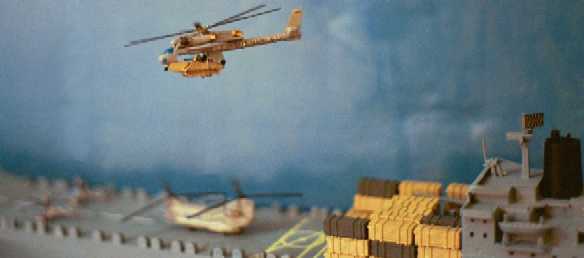
The Container Assault Ship can with its flight deck carry hundreds of ISO container BattleBoxes as well as launch V/TOL and STOVL aircraft whicle those with RO-RO ramps can simultaneously deliver amphibious vehicles and vehicles/cargo onto landing craft while far out to sea, eliminating the need for ports and piers.
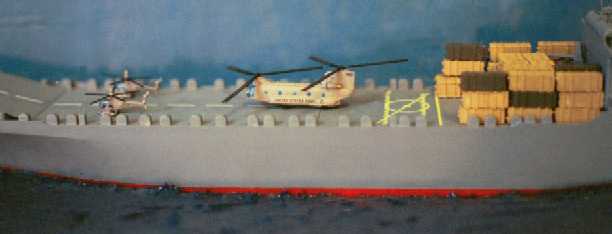
Aircraft like CH/MH-47 Chinooks and A/MH-6 Little Birds could also easily operate from Container Assault Ships
The Container Assault Ship can even defend itself from air attack by carrying its own STOVL fighter/attack aircraft. [Note we couldn't find 1/350 scale F-35 JSF models so F-18 Hornets are shown here as notional surrogates].
Ski Jumps for STOVL F-35 Joint Strike Fighters
With the addition of a bow ski jump, Container Assault Ships can launch STOVL fighters like the F-35 JSF with full ordnance loads. The JSFs would land vertically back onto the container assault ship for refuel and rearming.
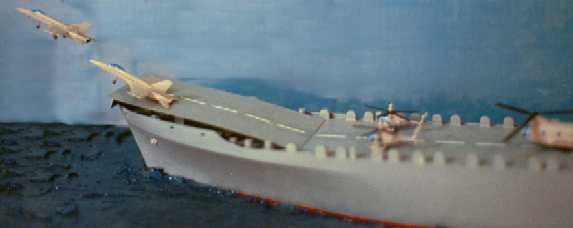
The Army already has several Bob Hope/Watson class sealift ships available to surge 3 Brigade's worth of vehicles but no berthing spaces for the Soldiers to operate them. These large ships need a pierside port to offload. To enable these vessels to offload via vehicle drive off onto the flight deck for AirCrane lift, an AirCrane helicopter must deploy on the deck during transit. For their vehicles to drive onto a USN LCAC and onto a floating air cushion pad under the stern and left/right ramps, one of the Bob Hope/Watson class RO-RO ships should be dedicated to just carrying LCACs lifted on deck using their 70 ton cranes. A LCAC Squadron on east/west coasts using the Navy's unused 26 LCACs would be set up for this purpose. The AirCrane or ships cranes would also lower into the water the floating air cushion ramps for the other RO-RO ships.
LCAC/RO-RO Ramp Interface

Many combination container and RO-RO ships could be used as Container Assault Ships
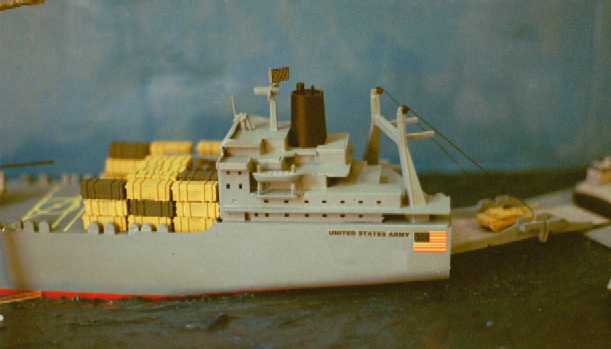
Here a container ship owned by the U.S. Army with a stern RO-RO ramp interfaces with a floating platform to enable U.S. Navy LCAC hovercraft to land and pick-up/drop-off cargo and vehicles.

This sideview shows how simultaneous actions can occur from the Container Assault Ship to speed deliveries ashore.
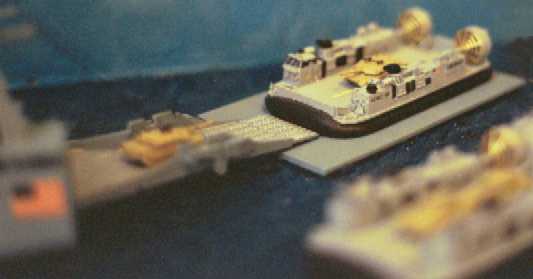
A close-up of the RO-RO ramp and LCAC landing platform
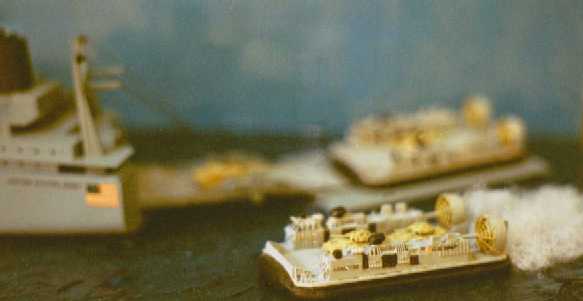
Here LCACs deliver a pair of Bradley medium Fighting Vehicles and a M1 Abrams heavy tank ashore at 60 mph speeds, over potential sea mines
 www.youtube.com/watch?v=QmZ2x4m0P6g
www.youtube.com/watch?v=QmZ2x4m0P6g
THE STUDIES
ACVLAP + LCAC Interface
www.combatreform.org/ACVLAPpages06to10.pdf
www.combatreform.org/ACVLAPpages11to15.pdf
CBO Strategic Mobility Options
The Amphigavins would function just like WWII DUKWs did except they are armored, cross-country mobile and can fight. Details:
Amphigavin amphibious tracked, armored fighting vehicle spearheads
1st TSG (A) EXCLUSIVE! Video clip of the Amphigavin in action!
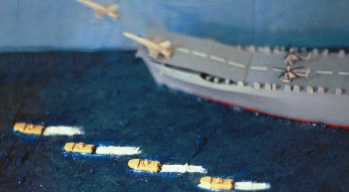
M113A4 AmphiGavins can splash into the water from RO-RO ramps and swim themselves ashore to secure beach landing sites (BLSs) for the follow-on echelons delivering non-amphibious ground vehicles
www.reocities.com/armysappersforward/amphigavins.htm
The Army APS-3 PrePo Squadron has 2 Battalions of Armor and Infantry vehicles staged at Diego Garcia in the same need-a-port and have no men to operate their vehicles predicament as the surge ships though they have a "head start" to possible contingency areas. ISO BBs should be placed on the APS-3 RO-RO ships to embark 300 x Combat Engineers for a short journey to offload their ships, living inside Battle Boxes en route. At least 100 of their M113s should be modified into AmphiGavins so Army Combat Engineers can swim selves to shore and secure a LOTS landing site and possibly clear a drop/landing zone for the rest of the Soldiers to link-up with their off-loaded equipment.
Cost for 100 AmphiGavins is $100M. Cost to Airborne-qualify the 3rd Infantry Division co-located at Fort Benning, Georgia's Jump School would be 3 weeks of time and NIL on money. To temporary house the rest of the 3rd ID for 3 weeks from Fort Stewart, Ga to attend jump school would be neglible.
TOTAL COST: $2.5 BILLION transforms THE ENTIRE U.S. ARMY into a containerized, rapid deployment force that compliments the existing RO-RO ships, C-130s, C-17s and transportation infrastructure and gains us new capabilities of battlefield FOB modularity, protection from enemy attacks to include WMDs, field living self-sufficiency, very fast sealift with direct delivery onto the beach, 3D air-mechanized maneuver, armored amphibious LOTS resupply and a host of new applications that will be discovered through realistic training now possible at all times.
Compare this to $1.3 BILLION just for one MPF-F quasi container ship/aircraft carrier that depends on failed V-22s to work to be effective--not likely. The unaffordable SeaPower 21 initiative and "Sea Basing" are just hidden ploys to get the USMC some more quasi-amphibious ships for itself at great cost while doing nothing to significantly fix America's power projection problems for all her Joint forces.
What about the Army's Prepositioned Ship Forces?: Armored, Amphibious Air Assault Resupply Capability for Army Regional Flotillas to act as force spearheads
DoD is excited today about the possibilities of "Sea Basing" to avoid having to rely on friendly nation-states to deploy into combat, as the loss of Turkey delayed the 4th Infantry Division from entering Iraq from a desirable northern 2D axis of advance. A 3D maneuver by air into Northern Iraq using the 173rd Airborne jumping in followed by the slow airlanding of 1st Infantry Division light M113A3 Gavin armored fighting vehicles (AFVs) backed by a few medium Bradley autocannon infantry carriers and M1 Abrams heavy tanks sealed off the area but did not fan out and block the escape of Saddam and his loyalists from Baghdad to prevent a guerrilla war from developing. A complimentary 2D maneuver or a faster 3D maneuver by airdropping the light tracked AFVs would have been decisive at preventing an insurgency that has killed 1,000 and maimed 4,000 Soldiers.
The Army is splitting its current APS-3 prepositioned ship force which has a 2+2 mix of armor and infantry battalions into 3 smaller Army Regional Flotillas (ARFs) composed of:
2 x Bob Hope/Watson RO-RO ships carrying:
Heavy Brigade (-)
1 x Armor BN
1 x Mechanized Infantry BN
Shallow Draft RO-RO with humanitarian supplies
1 x Container Ship of sustainment items
1 x container ship of ammo
30 days of supplies for 2.5 divisions (8 brigades)
______________________________________________
One of the war-winners in WWII was the amphibious truck called the DUKW which could shuttle men and supplies from ship-to-shore for direct delivery far inland. Today, the U.S. Army has lost this capability. In the Pacific, lacking roads the wheeled DUKWs would often get stuck.
U.S. Army in World War 2: The War in the Pacific: Leyte: the Return to the Philippines, Chapter XIV Measure of the Fighting
http://ibiblio.org/hyperwar/USA/USA-P-Return/USA-P-Return-14.html
"The 96th Division found the DUKW to be an excellent vehicle when waterborne but on land, regardless of the condition of the roads and terrain, it was not half as effective as the 21/2-ton cargo truck. On roads the DUKW was a traffic hazard and an obstacle to other cargo traffic."
We can regain this capability and solve wheeled immobility by fitting ARIS SPA waterjets and nose sections to the M113 Gavin light tracked AFVs in the new ARFs. Each ARF will have about 100 M113 Gavins available for conversion into "AmphiGavin" ship-to-shore capabilities. Details:
www.reocities.com/armysappersforward/amphigavins.htm
Resupply Must be Armored to Get Through
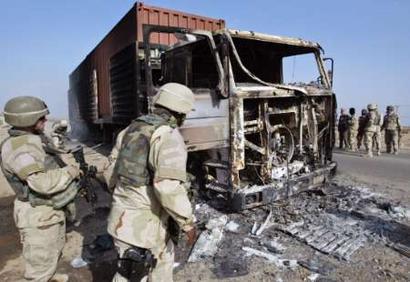
YES!

 www.youtube.com/watch?v=LlnDzCda_gY
www.youtube.com/watch?v=LlnDzCda_gY
A more recent and tragic lesson learned from Iraq is that resupply vehicles that are not armored and armed may simply not get through. During the march to Baghdad, the 3rd Infantry Division lost many wheeled supply trucks at a critical time when they were holding Baghdad International airport and the city center running low on ammunition. Amphigavins by their armored construction and armament could be fought their way through to wherever maneuver elements are to effect resupply.
Some of the AmphiGavins would have cut down rears to form flat beds to carry PLS flatracks that could be used to carry fuel, ammunition known as XM1108 variants. The flat racks would be covered in kevlar blankets and surrounded by double sidewalls with spacing to predetonate an RPG shaped charge warhead if struck to preserve the cargo. All AmphiGavins would have gunshielded machine gun mounts to deter and failing that fight off enemy attacks.
Armored Resupply for the Lethal Non-Linear Battlefield (NLB)
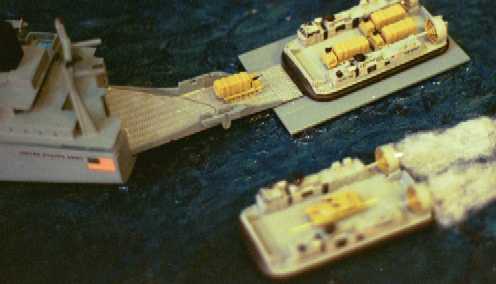
Cargo carrying XM1108 AmphiGavins can speed cargo like ISO Container BattleBoxes ashore by swimming themselves or hitching a ride using the LCAC platform RO-RO ramp interface
At a cost of about $1M per vehicle, we could have an armored resupply force of M113 AmphiGavins that could swim themselves ashore even if the Bob Hope/Watson class RO-RO ships cannot reach the pierside to offload.
Rapid Off-Load of Vehicles that cannot swim by RO-RO ship/LCAC interface
Once the AmphiGavins are ashore, they can secure the beach landing sites(s) for the LOTS lighterage to offload the RO-RO ships. This could be expedited by a few of the 26 unused Navy LCAC hovercraft being craned to the deck using organic cranes and placed in the water for offload. Under the 3 RO-RO ramps a floating landing platform would enable non-swimming Army vehicles to drive onto the LCAC for ferry to shore at 60 mph.
The AmphiGavin vehicle operators would fly by USAF jets to where the ARF ships are stored and embark and live on the RO-RO ship with their AmphiGavins using ISO Container housing modules. The AmphiGavin Soldiers would also be parachute qualified to jump into an area to link up with their ARF ships, or if no runways exist, jump into the BLS and provide the manpower to off-load all of the ARF's vehicles to get the ships out of the area where they are most vulnerable to enemy anti-shipping weapons. The Falklands war proved that ships at anchor are extremely vulnerable to air strafing, bombing and missile attacks.
Vertical Resupply from ARF Ships
CH-53E Sky and SpeedCranes for V/TOL air delivery

A CH-53E SpeedCrane takes off from the Container Assault Ship with an AmphiGavin snug under its skeletal fuselage as a "Streamlined External Load" (SEL)
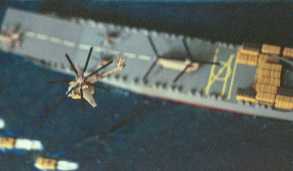
AmphiGavins can also by flown by SkyCranes/SpeedCranes over potential sea mines for 3D air assaults to secure BLSs and other mission objectives
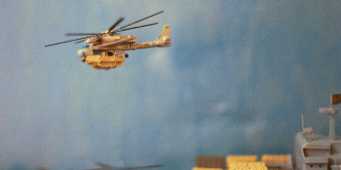
The basic CH-53E SkyCrane is fitted with Piasecki VTDP thrust units and wings can double ship-to-shore speeds making "SpeedCranes"
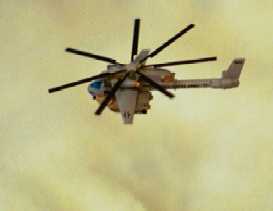
With its high 200+ mph speeds, the CH-53E SpeedCrane can fly high above the clouds to deliver cargo like M113A4 AmphiGavins and troops deep inland for 3D operational maneuver
We can regain this vertical ship-to-shore capability thanks to Erickson AirCrane owning the complete design rights to the S-64/CH-54 Skycrane and their building new heavy lift helicopters. The Army could lead the entire Joint Force into making SeaBasing a reality by buying off-the-shelf an Erickson SkyCrane with CH-53E engines/rotors and getting FAA certification. Cost would be $200M for first prototype and $20M per CH-53E SkyCrane. Upgraded SkyCranes with Piasecki Vectored Thrust Ducted Propellers (VTDP) and wings would double speeds to 200 mph and ranges to 2,000 miles. Details:
www.reocities.com/equipmentshop/nextchinook.htm
Each RO-RO ship has a helicopter landing pad that could transport at least two CH-53E SkyCranes to effect vertical ship-to-shore off-loads of combat vehicles up to 20 tons in weight. These would include "Air-Meching" the 11-ton M113 AmphiGavins and a force of 17-ton M8 Buford Armored Gun System light tanks with 105mm to 120mm guns. So even if enemy sea mines are present, we could simply off-load the ARF's under 20 ton items by SkyCranes through the air and the heavier 33-ton Bradleys and 70-ton Abrams by LCACs flying 8 feet over the water.
The ARF Air-Mech 3D Force can secure beach landing sites for the ARF to offload by LOTS/LCACs or seize a port with piers in event of enemy opposition or general lack of nation-state security (Haiti).
Another problem the CH-53E Skycrane can help solve is the bulk fuel resupply problem; a PLS/ISO pod carrying 5,000 gallons of fuel could be dropped off in a matter of seconds flying over potential enemy road ambush sites. Current "fat cow" aircraft bulk refueling is stuck inside a C-130 or CH-47 fuselage forcing the aircraft to stay on the ground as fuel is transfered to other containers and/or vehicles putting everything at risk to enemy attack. The CH-53 SkyCrane can touch down and drop its fuel pod off in seconds, reducing exposure time for everyone. A PLS truck of the force being resupplied can move the pod as required. In fact, the CH-53E Skycrane could offload a full fuel pod, then hover to an empty pod to fly it back to the ship for refilling.
Mission Flexibility
Unlike Stryker trucks which cannot swim at all, M113 Gavins are amphibious and with waterjets ship-to-shore amphibious just like Russian BMP-3 and BMD-3 tracked AFVs used by their Airborne and Naval Infantry. Since tracked AFVs are 28% more space/weight efficient than wheeled armor, they can also be flown combat loaded full of ammunition and supplies as well as RPG and roadside bomb resistant multiple armor layers and gunshields from C-130s and in our ARF scenario heavy-lift CH-53E SkyCranes. The vanilla Stryker starting at 19+ tons is simply too heavy for even C-130 fixed-wing lift let alone CH-53E SkyCrane rotary-wing air assault under all temperature conditions. The CH-53E SkyCrane would carry the Army's light tracked AFVs "snug up" under its skeletal fuselage eliminating the speed handicapped and dangerous sling-load carrying technique. However, once over the landing zone, the SkyCrane can stay at a hover and winch down the light tracked AFVs and need not have to land at all! So we can have the best of both world's; the streamlining of a tight carry and the hovering delivery of sling-loads without the drawbacks of either technique.
Battle Boxes for Everyone in the U.S. Army to be self-sufficient and fortified
The ARF Force would be the spearhead primarily 2D force and logistical means in concert with the 82nd, 173rd, 1-501st Airbornes as the main 3D maneuver force using USAF transport aircraft. The follow-on echelons need to already be loaded in ISO containers for rapid loading by container cranes onto ships holding 2-8,000 ISO containers. These should not be "Barney Rubble closets" full of junk tossed inside but actual fighting position, barracks, hospital, command post and specialty modules so we are always ready to train as we would fight. The tent city cannot protect our modern Army from theater basllistic missiles, cruise missiles, artillery, mortars, RSBs and RPGs because they have no hard outer shell. We must once and for all ADAPT to the outside mother earth environment and when we do this to insure our troops are clean and protected it means they are protected from Chem-Bio attacks. The hard shell of these ISO container "Battle Boxes" enables them to be dug into the ground as bunkers and hardened with sand, dirt and rock walls using pouches surrounding their sides like Concertainers now in use.
The 21st Century containerized, modular Army would rapidly load itself into container ships full of everything they need to fight without packing/repacking flimsy, rotting canvass tents. Their rolling stock vehicles would load onto the 8 RO-RO ships we have ready as surge sealift and sail to the area secured and ready to accept their offload by the ARF spearhead element. Details:
www.reocities.com/strategicmaneuver/battleboxes.htm
Defeating "The Threat From Above"
Here is a view from space of Norfolk Naval Base having THOUSANDS of ISO containers and cranes to rapidly load container ships like David Giles' FASTSHIP.
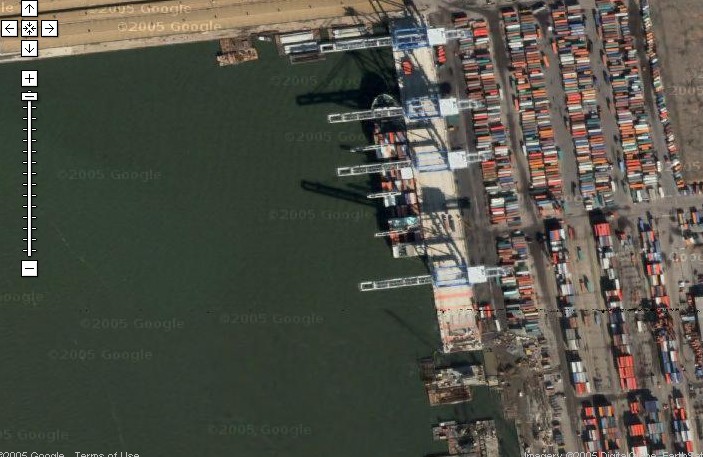
If we got smart in the U.S. military we'd containerize EVERYTHING to include aircraft, tanks and troop living spaces so we could not only rapidly deploy but be able to be mobile on land and be dug into the ground and be well-camouflaged from prying enemy eyes on land air and space...what's in the "Battle Box"??? A tank? A troop squad ready to open fire? An observation/attack aircraft?
You'd never know.
We need to containerize NOW to defeat possible enemy Surveillance Strike Complexes (SSCs).
CONCLUSION
Currently the DoD SeaBased initiative has "run aground" because the "long pole in the tent" is the lack of a 20-ton V/TOL aircraft and the sheer numbers of vehicles that have to be offloaded. By making a sizable portion of the Army vehicles swim, they reduce by 1/3 the load that STS delivery means have to transport. Couple this with unused Navy LCAC hovercraft and delivery speed is increased 10 times over shallow draft lighterage. Add the 100 mph 20-ton CH-53E SkyCrane from off the commercial firefighting market and delivery speeds increase 20 times. ISO Battle Box the entire U.S. Army and force deployment times reduce to just 1 day to load + ship transit time. If we obtain faster container ships like David Giles' FastShips which can do 40 mph (sorry I'm a "land lubber" and don't do the "knots" this and "knots" that thing because UNDERSTANDING WHAT IS BEING COMMUNICATED IS MORE IMPORTANT THAN SPEAKING IN YOUR PRIVATE CLUBHOUSE TERMINOLOGY) that transit time to anywhere in the world is now under 10 days. Function is what counts not BS vanity form.
REFERENCES
1. http://armedservices.house.gov/openingstatementsandpressreleases/108thcongress/04-03-24johnson.html
----------------------------------------------------------------------
TESTIMONY OF BRIGADIER GENERAL JEROME JOHNSON
DIRECTOR FOR PLANS, OPERATIONS AND READINESS
OFFICE OF THE DEPUTY CHIEF OF STAFF, G4 UNITED STATES ARMY AND BRIGADIER GENERAL KEVIN T. RYAN DIRECTOR OF STRATEGY, PLANS AND POLICY OFFICE OF THE DEPUTY CHIEF OF STAFF, G3 UNITED STATES ARMY
BEFORE THE HOUSE ARMED SERVICES COMMITTEE SUBCOMMITTEE ON READINESS UNITED STATES HOUSE OF REPRESENTATIVES
REGARDING ARMY PROPOSITIONED STOCKS SUPPORTING THE UNITED STATES ARMY
March 24, 2004
ARMY WORLD-WIDE STRATEGIC OPERATIONAL MANEUVER SLIDE PRESENTATION
Table of ContentsPPT Slide 01 Montage of AWSOM PPT Slide 02 Purpose PPT Slide 03 Main points PPT Slide 04 Death Spiral PPT Slide 05 Strategic view PPT Slide 06 Operational view PPT Slide 06a ISO Container Battle Boxes PPT Slide 07 3D Force-Entry PPT Slide 08 Airborne Sappers PPT Slide 09 Enemy war system PPT Slide 10 Landing Zone big PPT Slide 11 Large area need PPT Slide 12 M113A3 ESV Gavin PPT Slide 13 M113 combat good PPT Slide 14 Armor protects PPT Slide 15 Engineer devices PPT Slide 16 MICLIC firing PPT Slide 17 Airdrop/Airland PPT Slide 18 20th E-BDE (ABN) PPT Slide 19 CH-47D helo-lift PPT Slide 20 off-road mobile PPT Slide 21 Swim lake/rivers PPT Slide 22 360 security PPT Slide 23 Gear storage PPT Slide 24 RPG-proof armor PPT Slide 25 Many Upgrades PPT Slide 26 Stealth PPT Slide 27 Hybrid-Electric PPT Slide 28 TOW bunker-bust PPT Slide 29 BFV turret PPT Slide 30 Ext 25mm gun ASP-30mm Gas-operated Autocannon for multiple applications VIDEOS: First video shows excellent speedy cross-country mobility of M113 Gavin light tracked AFV and how it can plow through water and swim. 30mm autocannon HEI round explosive effects shown. www.combatreform.org/asp30mmonM113GAVIN.wmv One of the benefits of being gas-operated instead of electrically fired like the M231 version on the AH-64 Apache is ASP-30mm can be removed from the air/sea/ground vehicle and fired from a ground mount www.combatreform.org/asp30mmonTRIPOD.wmv Critical to defeating pirates/terrorists on the high seas, we need an explosive shell autocannon that can be mounted on very small boats; bullet-shooting machine guns lack the lethality to intimidate and destroy these enemies. Notice that even the civilian gunner has dressed up correctly to play the part of a deck gunner with kevlar helmet, flak jacket and floatation vest over the top. www.combatreform.org/asp30mmonNAVALGUNMOUNT.wmv The following unarmored wheeled trucks and dune buggy mounting of ASP-30 are not protected, mobile or stable enough in my opinion but included to show it is possible and the shaking and rolling of the entire vehicle when firing indicates the recoil forces involved
www.combatreform.org/asp30mmonBSHUMVEETRUCK.wmv
PPT Slide 31 ASP30mm M113 AFV PPT Slide 32 Javelin ATGM PPT Slide 33 FOE Phase I PPT Slide 34 APS 2D/3D PPT Slide 35 Amphib Sappers PPT Slide 36 Ocean-swim M113s PPT Slide 37 AirSea M113A3s PPT Slide 38 AmphiGavins PPT Slide 39 TAKR sealift PPT Slide 39a Ramps proven PPT Slide 39b LCAC/Ship mix PPT Slide 39c LCAC/craneship PPT Slide 40 200 men need PPT Slide 41 Compound CH-47G PPT Slide 42 C-130 seaplane For more info on Seaplane options click here PPT Slide 43 Tacamphib inland PPT Slide 44 FOE Phase II PPT Slide 45 Cargo 747s PPT Slide 46 Air/Sea Forces PPT Slide 47 Summary PPT Slide 48 Conclusion |
Author: 1st Tactical Studies Group (Airborne)
Email: itsg@hotmail.com Home Page: www.combatreform.org
|

After viewing our slides, please read General Zabecki's dynamite "reality check" for DoD:
Landpower In History
Strategists Must Regain An Understanding
Of The Role Of Ground Forces
Brigadier General David T. Zabecki, USAR
www.afji.com/AFJI/Mags/2002/August/landpower.html
SYNOPSIS:
Landpower In History
Of late, an airpower-centric mindset has taken hold among U.S. leaders that promises little risk to U.S. military personnel, but really has gained little for American interests. The principal historical lesson that strategists must understand is that physical occupation of territory by ground forces facilitates positive and direct control over the social, political, and economic destiny of that territory.
INTRO
The United States confronts challenges to its interests by drawing on diplomatic, economic, and military policy tools. Wise strategists know what each tool can do and when to apply it for maximum effect. As the U.S. meets its first great challenges of the 21st century, strategists must understand exactly what the military tools at their disposal can and cannot do. Least understood, perhaps, are ground forces, which are the military instrument most capable of producing lasting changes in the international arena.
Only ground forces can take and hold territory, which is an absolute prerequisite for any political, economic, or ideological change. Cold War strategists understood this. Of late, however, this joint approach has fallen victim to an airpower-centric mindset that promises little risk to U.S. military personnel, but really has gained little for American interests. As a result, many modern strategists have little understanding of the role and capabilities of ground forces.
The use of ineffectual air and missile strikes in recent years has led many of our potential enemies to conclude that Americans are willing to kill to advance their interests and values, but not willing to die for them. Our reluctance to put boots on the ground looks weak to friends and foes alike.
LESSONS OF HISTORY
Every war is different; no war is like the last one. Military planners cannot draw upon the same type of historical analysis that is central to the medical and legal professions. Military planners cannot forecast future contingencies in absolutes, because the very nature of war is that enemies adapt against each other. Instead, planners must confront the unexpected and apply their training, doctrine, and equipment to the situation at hand.
Defeat is often war's best teacher; opponents learn from their own mistakes and those of others. Strategists, therefore, must revise their plans continuously to account for countervailing enemy capabilities. Iraq, for example, continues to study the Coalition air campaign in Kosovo, so as to better blunt American airpower in any future conflict.
Military planners must adapt to the particulars of each new conflict, and historical lessons about how force has been used can guide these adaptations. Because training and technology change over time, the tactics used to capture a city in 1943 most likely would not work against that same city in 2003. But the strategic value of capturing that city does remain just as valid for strategy planning 60 years later.
The principal historical lesson that strategists must understand is that
During war, however, [nation-] states seize enemy territory to bolster their own power by forcibly imposing a new social contract on the conquered. Only ground forces can do this in newly seized territory. Soviet forces occupied Eastern Europe after World War II and were able to dictate the fate of those nations for the next 50 years-the more than 400 Red Army divisions occupying the ruins of Nazi Germany in 1945 gave Moscow a monopoly on violence and sealed Eastern Europe's fate.
Lasting Control Requires Physical Occupation. If forces do not occupy a given piece of territory, they cannot control what happens in it. Soviet forces did not seize Western Europe, and those nations escaped the yoke of Communism. By contrast, the American occupation of Imperial Japan and two-thirds of Nazi Germany transformed those two states into stable, prosperous democracies. It follows, then, that to control a territory effectively, ground forces must occupy it for an extended period.
As soon as a force withdraws from territory, it can quickly revert to a hostile base. The Vietnam-era truism that "we controlled the day; they controlled the night" is the best recent example of this. Because most American Soldiers withdrew to secure bases each night, Vietnamese Communist forces had carte blanche to maneuver to better effect for the coming day's operations.
Occupation Decisively Signals Intent. Occupation to defend territory signals that a nation is willing to spend its blood and treasure for that particular piece of ground and the resources contained therein. This signal is understood clearly by friends and foes alike. Robust NATO ground forces in Western Europe, for example, signaled clearly to the Soviet Union that because NATO troops were vulnerable to attack, the Alliance was willing to risk violence to preserve its interests against Soviet encroachment.
Defensive Occupation Raises The Cost Of Conquest. It follows, then, that if defensive occupation signals intent, it also raises the cost of conquest. Aggressors may still choose to attack, but they do so knowing that the price in personnel and materiel will be much higher than if the territory were undefended. Moreover, if the defenders can make the price of aggression sufficiently costly, the result is deterrence. This balance between costs and benefits is the basis of traditional conventional deterrence. Thus, NATO ground forces stationed in Western Europe meant that, although the Soviets might invade, the costs would likely exceed the benefits.
Occupation Limits Strategic Choices. Territory occupied by a nation's military forces cannot be used by others. In peacetime, sacrosanct national boundaries ensure that states deal with one another through political and economic means. Occupation prevents encroachment by adventurous states. The presence of NATO peacekeepers in Kosovo, for example, precludes further attempts by either the Serbs or the Kosovars to redraw boundaries. Unlike observer overflights, which can be avoided or interdicted, the NATO ground force in Kosovo is a tripwire that cannot be avoided.
Destruction Of Enemy Ground Forces Produces Political Leverage. Occupied territory limits an enemy's strategic options during conflicts as well as in peacetime. Ground forces take territory by destroying or otherwise neutralizing the enemy forces in that territory. These tactical and operational gains create a cascading effect that reduces and eventually eliminates the enemy's strategic flexibility.
Each time an enemy unit is destroyed, the enemy's overall capabilities decrease, making it harder for that enemy to prosecute its political objectives. As additional territory is seized, the restrictive effects cascade, and the enemy government's diminishing ability to execute its will produces diplomatic concessions as the defeated power cuts its losses rather than face capitulation.
As Coalition forces surged into southern Iraq and Kuwait, for example, Saddam Hussein's diplomatic position eroded rapidly. Prior to the start of the ground war, Hussein was able to reject calls to abandon his newly occupied territory in a negotiated withdrawal. After the start of the ground offensive, however, that option of intact withdrawal was stripped from him, as many of his heavy forces were destroyed in the field. He was forced to make more expansive diplomatic concessions to end the war.
Airpower Alone Can Coerce Only Slow And Indecisive Negotiations. Air forces cannot occupy territory; they can only attack infrastructure or interdict enemy operations within the territory. Whenever aircraft are not overhead, the enemy has freedom of action. Indeed, even when aircraft are present, dispersed enemy forces can still operate, albeit with decreased effectiveness. Serbia, for example, actually increased ethnic-cleansing activities in Kosovo despite the NATO air campaign. After all, it is very hard to decide from a mile up who is a paramilitary, and harder still to kill that paramilitary without harming civilians-even with a laser-guided bomb. Moreover, continued difficulties with concealment, dispersal, and decoys make true control of the battlefield by air forces a questionable issue.
Because hostile governments are able to operate despite air interdiction, it becomes harder to pursue diplomatic objectives through military means. Sustained bombing of North Vietnam achieved no lasting effect because both Hanoi and the North Vietnamese army remained functional. Hanoi was willing to absorb the punishment from the air and saw no reason to concede the fight to the United States.
The Changing Nature Of Deterrence. The nature of deterrence is changing. In the post-9/11 campaign to combat dispersed, often substate terrorism, classic deterrence frequently does not work. Al Qaeda, for example, appears content to abandon its destroyed bases in Afghanistan and re-emerge elsewhere. There is a real need to find a new way to defeat or deter such foes on the ground in their widely dispersed operating bases. [Editor: Air-Mech-Strike]
Simply put, the fact that the U.S. can rapidly put boots-on-the-ground anywhere in the world gives our opponents pause. Missile strikes interdict; American ground forces destroy and occupy. This capacity for destruction terrifies, and fear is the currency of deterrence. As our foes realize that there are no more safe havens because we will bring the battle to them, conventional deterrence will resume.
The Fallacy Of Shock Without Maneuver. Military forces take and hold territory by applying firepower (shock) and maneuver (positional advantage). These classic elements of combat power act in concert. Maneuver positions the forces to better apply shock, which destroys or disrupts the enemy and creates favorable conditions for subsequent maneuver. When ground forces operate on a piece of terrain, they restrict or prevent enemy maneuver. The cumulative effect of this continuing cycle of controlled violence renders the enemy ineffective and delivers victory.
Designed for speed, maneuverability, and range, aircraft cannot be heavily armored. Aircraft cannot remain in fixed positions; to stop moving is to die. As a result, aircraft can only produce a temporary battlefield presence. The moment they expend their fuel or ammunition, aircraft must leave to return to distant bases, thereby freeing the enemy to maneuver.
The only way to overcome this problem is to constantly cycle aircraft to and from the battlefield. This places a tremendous stress on the personnel and equipment involved and requires large numbers of aircraft as well as mountains of stores and fuel.
One study of the "Rolling Thunder" air campaign estimated that every dollar of destruction caused to North Vietnam cost America $9.60 to produce. Indeed, if one considers the resource drain of Operation Northern Watch's no-fly zone, the notion of a large-scale, sustained, independent air campaign quickly becomes prohibitive.
By contrast, ground forces are designed to be sustained without leaving the battlefield, through forward area re-supply points just behind the forward edge of the battle area. They can maintain their battlefield presence and continue to deliver shock and maneuver-with fewer units and with significantly lower levels of consumption.
Airpower cannot maneuver in the classical sense, and it cannot prevent reoccupation by enemy ground forces. Airpower, by itself, is essentially nothing more than an extension of firepower. And firepower by itself, no matter how devastating, cannot produce a lasting military effect. [AMEN!]
Airpower and ground forces must work in a combined, synergistic relationship. World War I represents a tragic attempt to produce military victory through firepower alone. The German Blitzkrieg in World War II and the American AirLand Battle in the Gulf War, however, are remarkable examples of the combined application of shock and maneuver with technologically sophisticated equipment.
The Problem With Proxies. The experiences of Kosovo and Afghanistan have led many to the erroneous conclusion that the U.S. can "buy" cheap ground combat power by employing local ground force proxies where needed. Ideally, these hypothetical proxies will prosecute future ground wars supported by American stand-off weapons. This assumption, however, is dangerously misguided.
Proxies simply may not exist. American strategy and force structure cannot be predicated on the assumed availability of allied ground forces. Local proxies were available in Afghanistan, but not in Mogadishu. Moreover, available local proxies may not fight effectively. The poor performance of the South Vietnamese army made it a liability rather than an asset. American planners cannot guarantee any combat effectiveness that they themselves do not create.
In addition, although local proxies may be aligned with overall American objectives, this will not necessarily produce effective command and control over them. Local proxies' own allegiances may impugn American objectives. To understand this problem, one need only recall that al Qaeda and Taliban commanders were allowed to escape by using tribal arrangements and bribes.
Finally, the consistent use of foreign proxies to protect U.S. interests corrodes America's international standing. To friends and allies, such a policy signals that American Soldiers are not willing risk death or even injury and privation to protect the country's interests, which by extension means that the U.S. would be even less willing to risk anything to protect friendly and allied interests. Moreover, perceiving weakness, our foes would further challenge American interests.
Foreign proxies must be employed on a case-by-case basis. Foreign allies and friends are vital to any American military effort, but they are not likely to accept an ancillary role based on an "our airpower, your bodies" strategy. Washington must lead from the front, using American ground forces to bolster coalition forces when possible and to defend American interests alone when necessary. This will ensure battlefield victory and diplomatic respect.
LASTING CHANGES
Occupying territory creates the conditions for lasting political and economic changes while limiting other international actors' freedom of action. History offers no starker lesson than this.
Acting in concert with the other services, ground forces create lasting changes on the battlefield and at the international level. Creating lasting change will be absolutely critical when the U.S. confronts the unexpected adversaries of this century. Given the changing nature of deterrence and the need to retain the traditional balance of shock and maneuver, American ground forces remain indispensable.
War is an extension of political will; therefore, it is essential to put American boots-on-the-ground to defend American interests. We cannot pay others to fight our wars while we strike from over the horizon. But this doesn't require a return to the massed infantry assaults of World War II. Rather, what is needed is a highly trained and superbly led force equipped with every advantage that 21st century American technology can provide, including the world's finest air support.
The U.S. must continue to maintain and further transform its robust ground forces to protect our national interests. Today we enjoy a combat overmatch so fearsome that our adversaries must look to asymmetric warfare to even begin to challenge our power. This predominance is a political asset, not a liability. Transformation will guarantee that American ground forces remain preeminent.
Navy "SuperCarrier" Racket Threatened by U.S. Army Mobile Off-Shore Bases (MOBs)
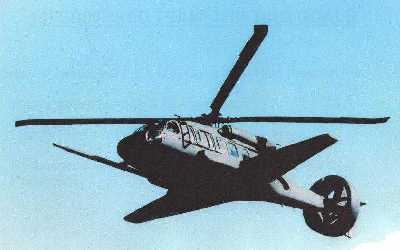
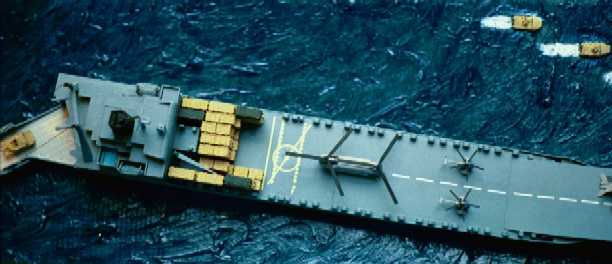
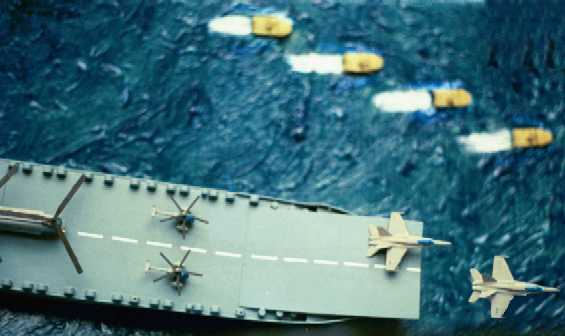
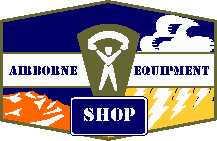
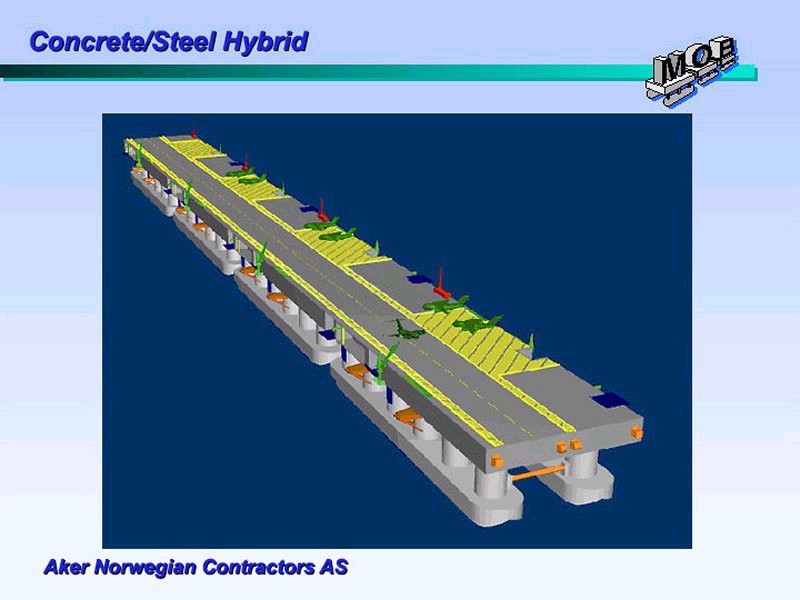
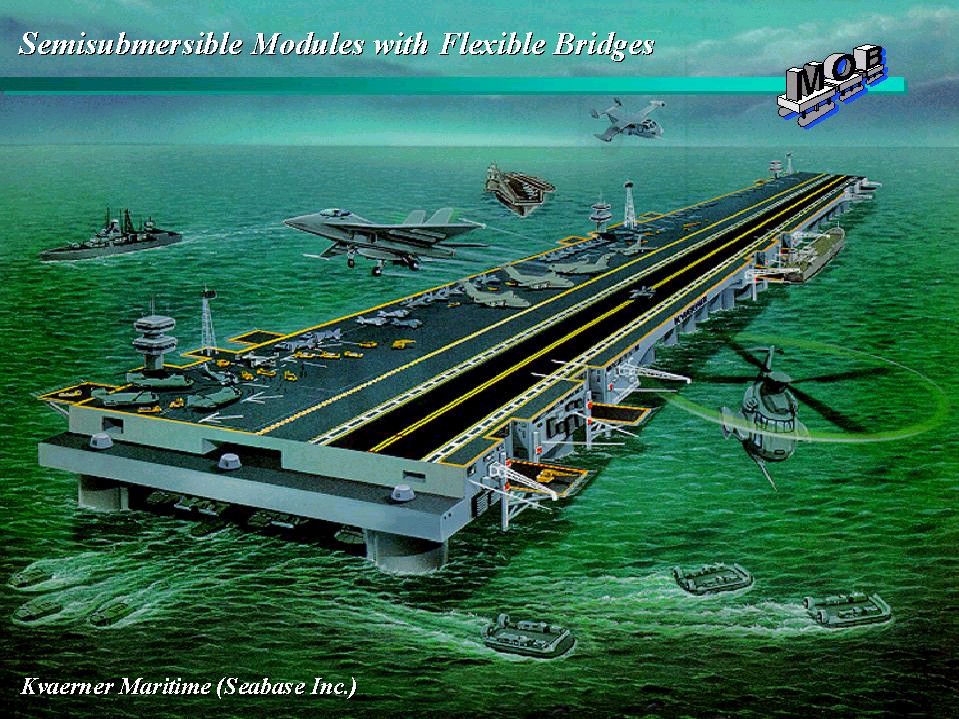
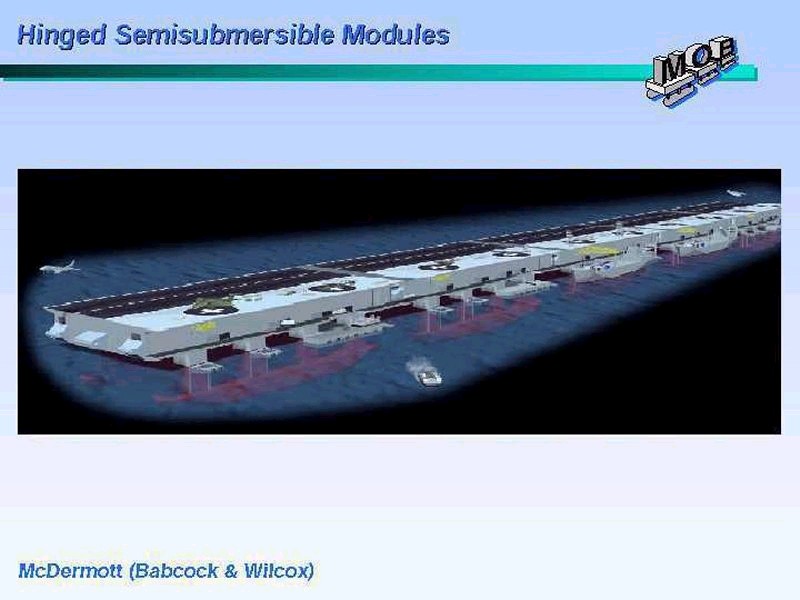
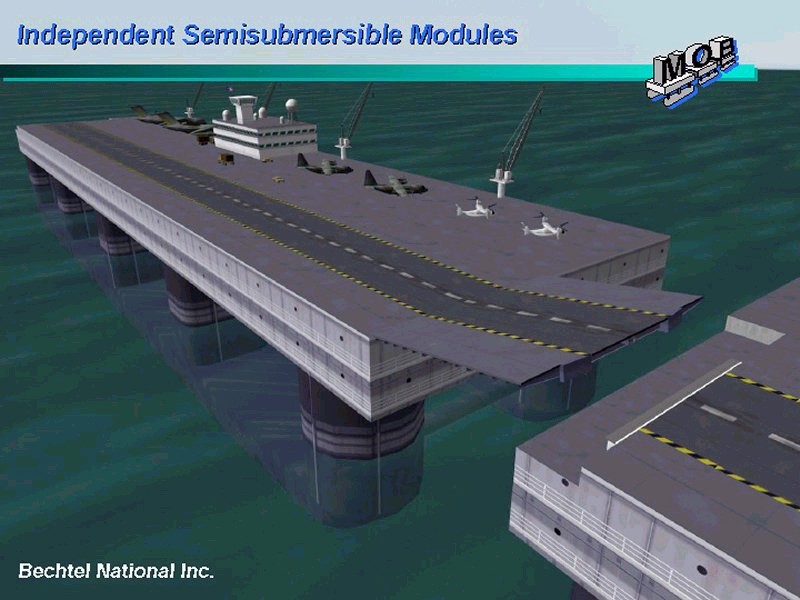
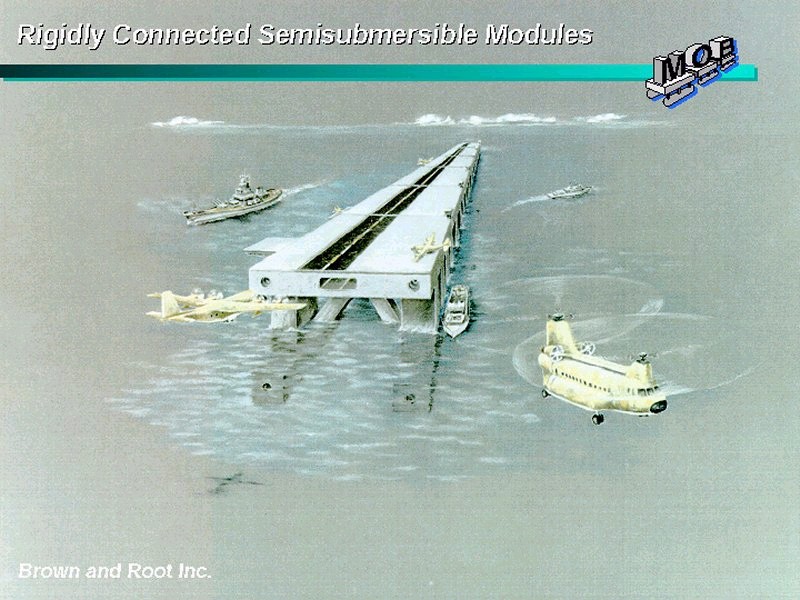
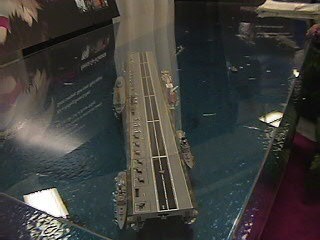
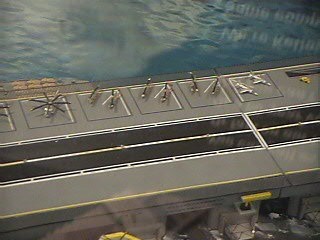
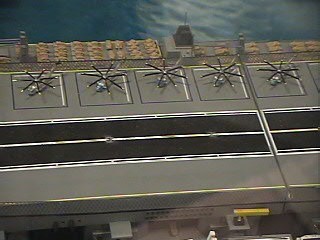
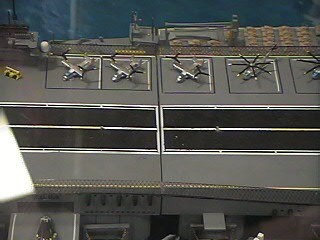
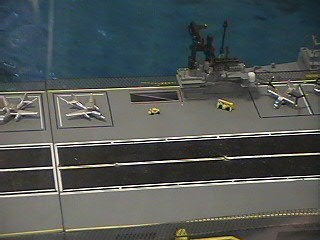
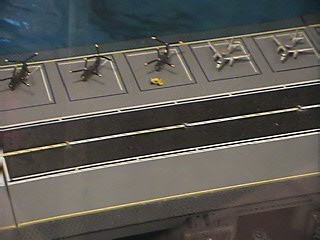
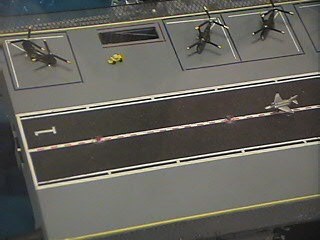
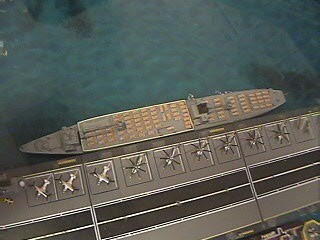

 Return to U.S. Army Airborne Equipment Shop
Return to U.S. Army Airborne Equipment Shop